Paul van Yperen's Blog, page 229
July 7, 2019
15 films we loved at Il Cinema Ritrovato
Looking back at Il Cinema Ritrovato 2019, we can definitively say the 33rd edition was one of the best editions yet - and one of the warmest. The Fox programme offered some unforgettable masterpieces, just like the 1919 programme did. A surprise for me were the films by Egyptian director Youssef Chahine. And I was very happy to see the last film by Agnès Varda, presented by her daughter Rosalie, and to experience Chaplin's The Circus with a huge orchestra and thousands of other laughing people at Bologna's Piazza Maggiore.
Here are my 15 favourite films of this year's festival. Ivo Blom also did a post on Il Cinema Ritrovato at his personal blog. Check it out.
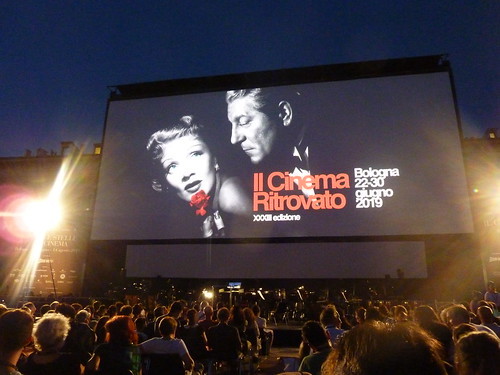
Piazza Maggiore, Cinema Ritrovato, Bologna, Italia.
15. Becky Sharp (Rouben Mamoulian, 1935)
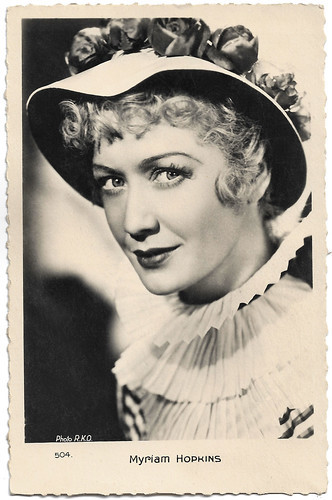
French postcard by Editions EC, Paris, no. 504. Photo: RKO. Miriam Hopkins in Becky Sharp (Rouben Mamoulian, 1935).
14. En cas de malheur (Claude Autant-Lara, 1958)
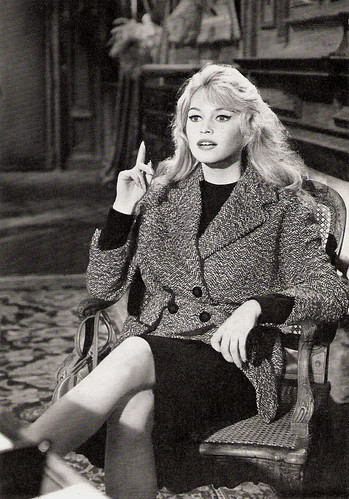
German postcard, no. 1. Photo: Unifrance-Film. Brigitte Bardot in En cas de malheur/Love is my profession (Claude Autant-Lara, 1958).
13. I Clowns (Federico Fellini, 1970)
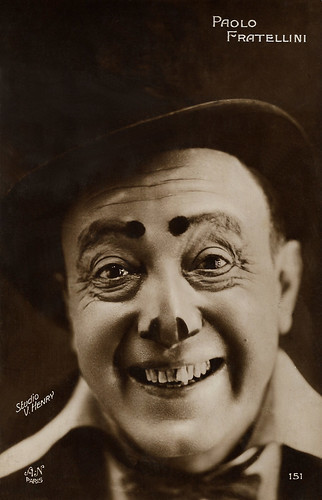
Paolo Fratellini. French postcard by A.N., Paris, no. 151.
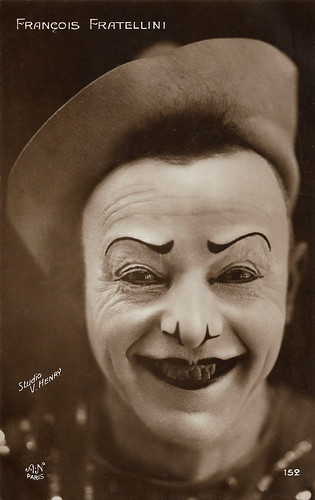
François Fratellini. French postcard by A.N., Paris, no. 152. Photo: Studio V. Henry. One of the highlights in Fellini's mockumentary I Clowns (1970) is a scene in which the maestro recreates a performance of the famous Fratellini brothers in a mental asylum. The wit, charm, and superb acting techniques of the three clowns were widely admired. By 1923, the Fratellini brothers had become the darlings of the Parisian intellectuals. They were lauded in print and worshipped by adoring fans who would show up at the circus just in time for the Fratellini entree, which sometimes ran as long as forty-five minutes.
12. Ride Lonesome (Budd Boetticher, 1959)
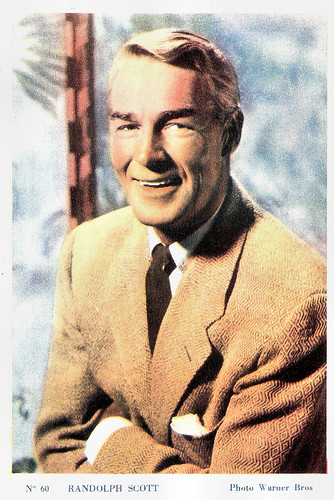
Randolph Scott. British postcard, no. 60. Photo: Warner Bros. Entertaining Western with an impressive Scott and Pernell Roberts, better known as Adam Cartwright from the classic TV series Bonanza.
11. Moulin Rouge (John Huston, 1952)
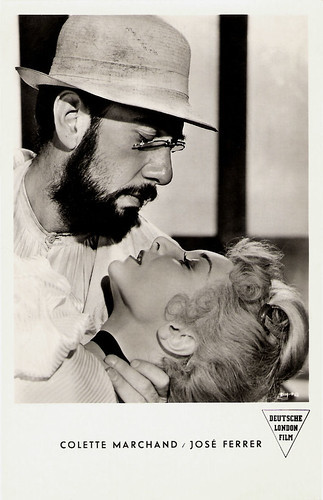
German postcard. Photo: Deutsche London Film. José Ferrer and Colette Marchand in Moulin Rouge (John Huston, 1952). Beautiful ode to 19th Century Montmarte and its music halls and artists like Henri de Toulouse-Lautrec. Huston opens the film with a colourful 20 minute Can-Can sequence which brilliantly captures the atmosphere, and sets the tone for the drama to follow.
10. Siraa Fil-Wadi/The Blazing Sun (Youssef Chahine, 1954)
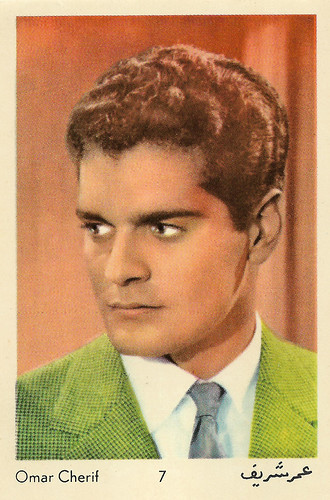
Omar Sharif. Egyptian collectors card, no. 7. Siraa Fil-Wadi was Omar Sharif's film debut. Director Youssef Chahine discovered the handsome young Michel Chahoub on the streets in Cairo and invited him for a screentest. Re-named Omar El Cherif, he starred opposite the renowned Egyptian actress Faten Hamamah whom he married in 1955.
9. Film ohne Titel (Rudolf Jugert, 1948)
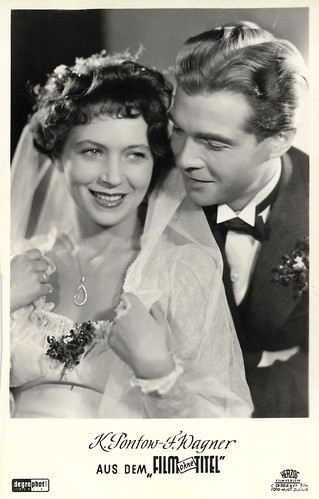
German postcard by Degro Phot., Berlin, no. C 187. Photo: Herzog Filmverleih / Camera Film / Kurt Julius. Fritz Wagner and Käte Pontow in Film ohne Titel/Film Without Title (Rudolf Jugert, 1948). A pleasant surprise was this funny and unconventional comedy about making a film in Germany after the war.
8. College (James W. Horne, Buster Keaton, 1927)
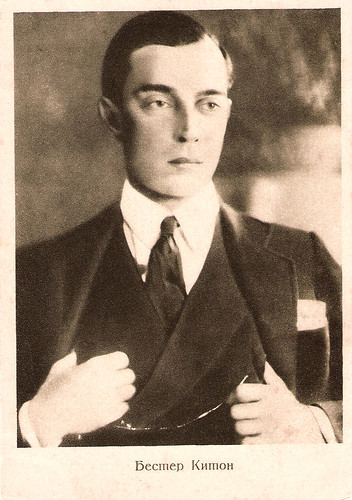
Buster Keaton . Russian postcard, no. 1725, 1927.
7. Dr. No (Terence Young, 1962)
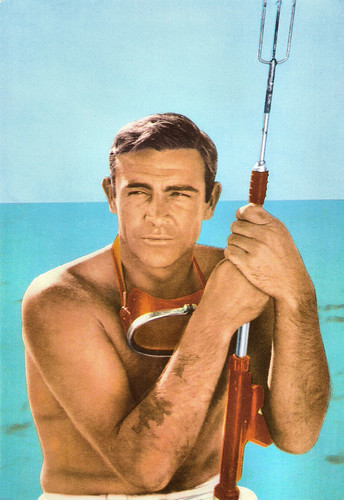
Spanish postcard by Eurocromo S.L., no. R 001. Photo: Sean Connery in Dr. No (Terence Young, 1962). Although the copy we saw was not superb, the first Bond is still a joy to watch. Connery is excellent, as are the sets by Ken Adam, John Barry's Bond theme and the title design by Maurice Binder. The only disappointment is the so-called classic scene with Ursula Andress rising from the sea in a white bikini. It sounds good, but it's rather tame and Andress acts wooden. Halle Berry redid that scene in a later Bond adventure and then the screen really sizzled.
6. Varda par Agnès (Agnès Varda, 2019)
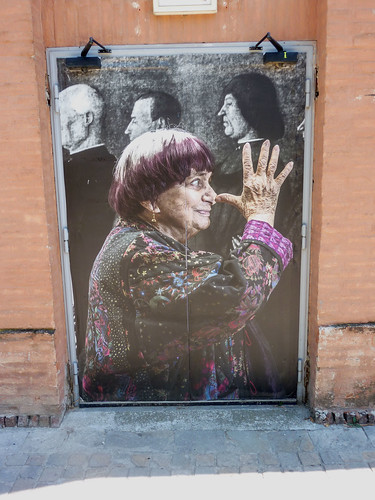
Wall Art Cineteca di Bologna, Cinema Ritrovato, Bologna, Italia. Adieu, madame Varda!
5. The Winning of Barbara Worth (Henry King, 1926)
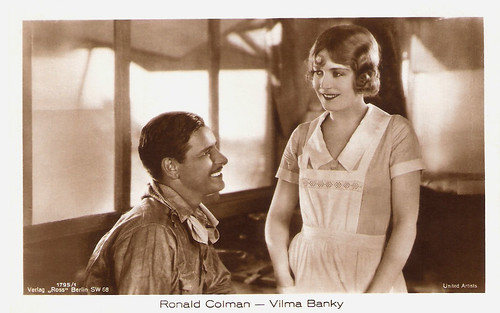
German postcard by Ross Verlag, no. 1795/1, 1927-1928. Photo: United Artists. Ronald Colman and Vilma Banky in The Winning of Barbara Worth (Henry King, 1926). A wonderful silent Western full of great stunts, and three intriguing stars, also including the young and delicious Gary Cooper .
4. Street Angel (Frank Borzage, 1928)
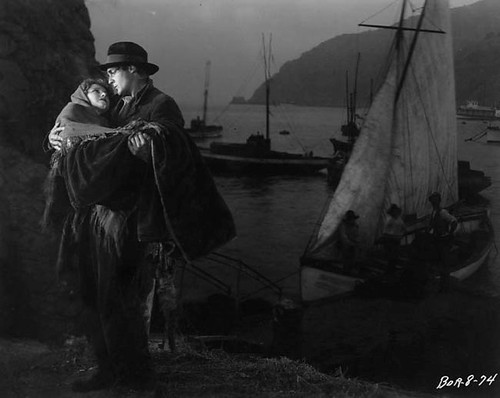
Publicity still of Janet Gaynor and Charles Farrell in Street Angel (Frank Borzage, 1928). Collection: The Island of Cinema @ Flickr. My favourite romantic couple from silent Hollywood in their first part-sound film.
3. Sången om den eldröda blomman/Song of the Scarlet Flower (Mauritz Stiller, 1919)
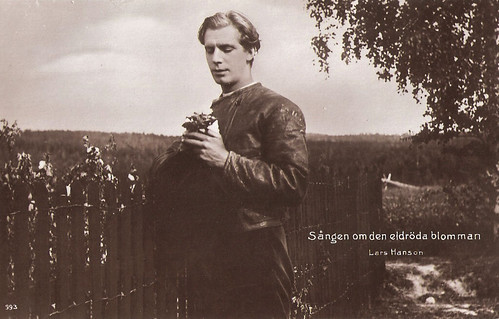
Swedish postcard by Forlag Nordisk Konst, Stockholm, no. 993. Photo: Svenska Biografteatern, Stockholm. Lars Hanson in Sången om den eldröda blomman/Song of the Scarlet Flower (Mauritz Stiller, 1919). This was another suprise, an excellent and technically perfect Mauritz Stiller production of 1919. 'Large Handsome' plays the merry and carefree Olof who wins the heart of Edith Erastoff by daringly steering logs through the rapids on a wild river. An incredible stunt.
2. The Circus (Charles Chaplin, 1928)
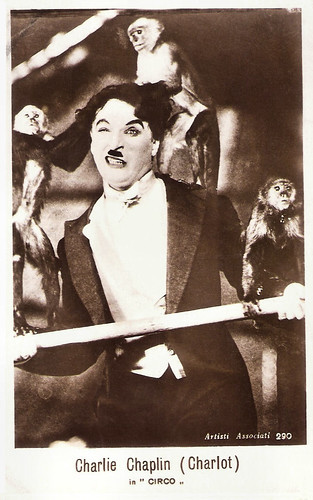
Italian postcard by G.B. Falci, Milano, no. 290. Photo: United Artists. Charlie Chaplin in The Circus (Charles Chaplin, 1928). Highlight is of course the scene in which Charlie is doing a tight rope wire act and tries to balance himself while loose monkeys crawl all over him, thus disrupting his act. His gags brought forth as many laughs at the Piazza Maggiore during Cinema Ritrovato as it did in 1928. Great fun.
1. 3 Bad Men (John Ford, 1926)
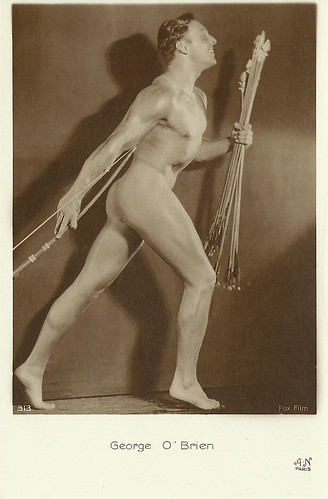
George O'Brien. French postcard by A.N., Paris, no. 313. Photo: Fox Film. Collection: Didier Hanson. John Ford's classic silent Western 3 Bad Men (John Ford, 1926) was our favourite film this year. A sweeping, entertaining adventure which includes an impressive church burning scene and the Oklahoma Land Rush scene with an abandoned infant. The cast includes the excellent Olive Borden, Tom Santschi and Dutch actor Lou Tellegen as the evil Sheriff. Although my postcard choice perhaps suggests otherwise, George O'Brien is the romantic hero of the film and not one of the three title characters.
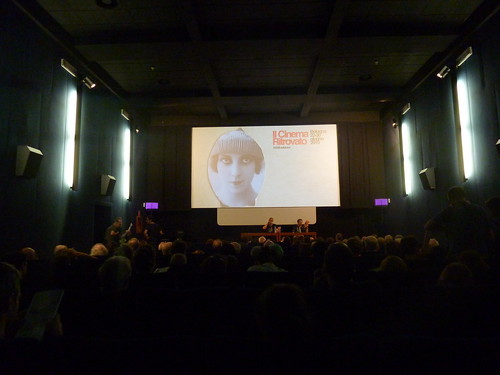
Musidora, Sala Mastroianni, Cineteca di Bologna, Cinema Ritrovato, Bologna, Italia.
Later this week we will do two posts on new acquisitions we found at the Il Cinema Ritrovato Book Fair.
Here are my 15 favourite films of this year's festival. Ivo Blom also did a post on Il Cinema Ritrovato at his personal blog. Check it out.

Piazza Maggiore, Cinema Ritrovato, Bologna, Italia.
15. Becky Sharp (Rouben Mamoulian, 1935)

French postcard by Editions EC, Paris, no. 504. Photo: RKO. Miriam Hopkins in Becky Sharp (Rouben Mamoulian, 1935).
14. En cas de malheur (Claude Autant-Lara, 1958)

German postcard, no. 1. Photo: Unifrance-Film. Brigitte Bardot in En cas de malheur/Love is my profession (Claude Autant-Lara, 1958).
13. I Clowns (Federico Fellini, 1970)

Paolo Fratellini. French postcard by A.N., Paris, no. 151.

François Fratellini. French postcard by A.N., Paris, no. 152. Photo: Studio V. Henry. One of the highlights in Fellini's mockumentary I Clowns (1970) is a scene in which the maestro recreates a performance of the famous Fratellini brothers in a mental asylum. The wit, charm, and superb acting techniques of the three clowns were widely admired. By 1923, the Fratellini brothers had become the darlings of the Parisian intellectuals. They were lauded in print and worshipped by adoring fans who would show up at the circus just in time for the Fratellini entree, which sometimes ran as long as forty-five minutes.
12. Ride Lonesome (Budd Boetticher, 1959)

Randolph Scott. British postcard, no. 60. Photo: Warner Bros. Entertaining Western with an impressive Scott and Pernell Roberts, better known as Adam Cartwright from the classic TV series Bonanza.
11. Moulin Rouge (John Huston, 1952)

German postcard. Photo: Deutsche London Film. José Ferrer and Colette Marchand in Moulin Rouge (John Huston, 1952). Beautiful ode to 19th Century Montmarte and its music halls and artists like Henri de Toulouse-Lautrec. Huston opens the film with a colourful 20 minute Can-Can sequence which brilliantly captures the atmosphere, and sets the tone for the drama to follow.
10. Siraa Fil-Wadi/The Blazing Sun (Youssef Chahine, 1954)

Omar Sharif. Egyptian collectors card, no. 7. Siraa Fil-Wadi was Omar Sharif's film debut. Director Youssef Chahine discovered the handsome young Michel Chahoub on the streets in Cairo and invited him for a screentest. Re-named Omar El Cherif, he starred opposite the renowned Egyptian actress Faten Hamamah whom he married in 1955.
9. Film ohne Titel (Rudolf Jugert, 1948)

German postcard by Degro Phot., Berlin, no. C 187. Photo: Herzog Filmverleih / Camera Film / Kurt Julius. Fritz Wagner and Käte Pontow in Film ohne Titel/Film Without Title (Rudolf Jugert, 1948). A pleasant surprise was this funny and unconventional comedy about making a film in Germany after the war.
8. College (James W. Horne, Buster Keaton, 1927)

Buster Keaton . Russian postcard, no. 1725, 1927.
7. Dr. No (Terence Young, 1962)

Spanish postcard by Eurocromo S.L., no. R 001. Photo: Sean Connery in Dr. No (Terence Young, 1962). Although the copy we saw was not superb, the first Bond is still a joy to watch. Connery is excellent, as are the sets by Ken Adam, John Barry's Bond theme and the title design by Maurice Binder. The only disappointment is the so-called classic scene with Ursula Andress rising from the sea in a white bikini. It sounds good, but it's rather tame and Andress acts wooden. Halle Berry redid that scene in a later Bond adventure and then the screen really sizzled.
6. Varda par Agnès (Agnès Varda, 2019)

Wall Art Cineteca di Bologna, Cinema Ritrovato, Bologna, Italia. Adieu, madame Varda!
5. The Winning of Barbara Worth (Henry King, 1926)

German postcard by Ross Verlag, no. 1795/1, 1927-1928. Photo: United Artists. Ronald Colman and Vilma Banky in The Winning of Barbara Worth (Henry King, 1926). A wonderful silent Western full of great stunts, and three intriguing stars, also including the young and delicious Gary Cooper .
4. Street Angel (Frank Borzage, 1928)

Publicity still of Janet Gaynor and Charles Farrell in Street Angel (Frank Borzage, 1928). Collection: The Island of Cinema @ Flickr. My favourite romantic couple from silent Hollywood in their first part-sound film.
3. Sången om den eldröda blomman/Song of the Scarlet Flower (Mauritz Stiller, 1919)

Swedish postcard by Forlag Nordisk Konst, Stockholm, no. 993. Photo: Svenska Biografteatern, Stockholm. Lars Hanson in Sången om den eldröda blomman/Song of the Scarlet Flower (Mauritz Stiller, 1919). This was another suprise, an excellent and technically perfect Mauritz Stiller production of 1919. 'Large Handsome' plays the merry and carefree Olof who wins the heart of Edith Erastoff by daringly steering logs through the rapids on a wild river. An incredible stunt.
2. The Circus (Charles Chaplin, 1928)

Italian postcard by G.B. Falci, Milano, no. 290. Photo: United Artists. Charlie Chaplin in The Circus (Charles Chaplin, 1928). Highlight is of course the scene in which Charlie is doing a tight rope wire act and tries to balance himself while loose monkeys crawl all over him, thus disrupting his act. His gags brought forth as many laughs at the Piazza Maggiore during Cinema Ritrovato as it did in 1928. Great fun.
1. 3 Bad Men (John Ford, 1926)

George O'Brien. French postcard by A.N., Paris, no. 313. Photo: Fox Film. Collection: Didier Hanson. John Ford's classic silent Western 3 Bad Men (John Ford, 1926) was our favourite film this year. A sweeping, entertaining adventure which includes an impressive church burning scene and the Oklahoma Land Rush scene with an abandoned infant. The cast includes the excellent Olive Borden, Tom Santschi and Dutch actor Lou Tellegen as the evil Sheriff. Although my postcard choice perhaps suggests otherwise, George O'Brien is the romantic hero of the film and not one of the three title characters.

Musidora, Sala Mastroianni, Cineteca di Bologna, Cinema Ritrovato, Bologna, Italia.
Later this week we will do two posts on new acquisitions we found at the Il Cinema Ritrovato Book Fair.
Published on July 07, 2019 22:00
July 6, 2019
Cameron Diaz
Blue-eyed, natural blonde Cameron Diaz (1972) is a former model and film actress. Her big break arrived in 1994 with the Jim Carrey film The Mask. Roles in My Best Friend's Wedding (1997), There's Something About Mary (1998), and Shrek (2001) – in which she voiced Princess Fiona – solidified her as one of the most bankable Hollywood stars. Her other film credits include hits like Charlie's Angels (2000), Gangs of New York (2003) and In Her Shoes (2005).
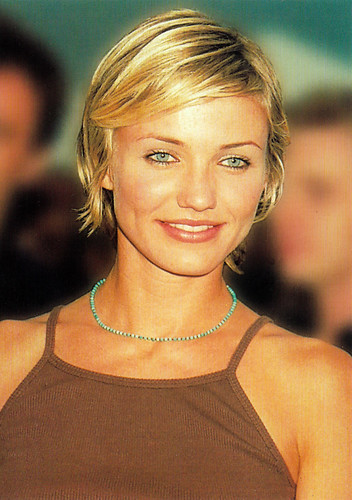
British postcard by Heroes Publishing LTD., London, no. SPC 3328.

French postcard by Forum Cartes et Collections, Nouaillé, no. 35. Cannes (06), 2003. Photo: Anne-Christine Poujoulat-STF. Caption: The director Martin Scorsese (middle), the actor Leonardo DiCaprio (left) and the actress Cameron Diaz pose for the photographers before a screening of Gangs of New York on 20 May 2002 during the 55th Cannes Film Festival.

British postcard by Pyramid, Leicester, no. PC 2051.
An adventurous, independent and a tough kid
Cameron Diaz was born in 1972 in San Diego, California. She is the daughter of a Cuban-American father and an Anglo-German mother.
She graduated from Long Beach Polytechnic (Poly) High School (Class of 1990) in Long Beach, California. As a member of that school's 'Polyettes' dance-drill team, Cameron performed during half-time at football games. Self described as "adventurous, independent and a tough kid", she lived in such varied locales as Japan, Australia, Mexico, Morocco, and Paris.
Returning to California at the age of 21, Diaz was discovered by a photographer at a Hollywood party. He helped her land a contract with the Elite Modeling Agency. She was working as a model when she auditioned for a big part in the comedy The Mask (Chuck Russell, 1994), based on a Dark Horse comic book series of the same name.
To her amazement and despite having no previous acting experience, she was cast as the female lead in the film opposite Jim Carrey. It proved to be a great acting debut for her. The Mask is both a crazy comedy, which surpasses the imagination, but also works well as a thriller with a dark atmosphere.
Over the next 3 years, she honed her acting skills in such low budget independent films as The Last Supper (Stacy Title, 1995), Feeling Minnesota (Steven Baigelman, 1996) with Keanu Reeves , and Head Above Water (Jim Wilson, 1996) with Harvey Keitel.
She returned to main stream films in My Best Friend's Wedding (P.H. Hogan, 1997), in which she held her own against leading lady Julia Roberts. In 1998, she earned full fledged star status for her performance in the box office smash There's Something About Mary (Bobby Farrelly, Peter Farrelly, 1998) with Matt Dillon and Ben Stiller.
Her following two projects — the sports drama Any Given Sunday (Oliver Stone, 1999) starring Al Pacino, and Spike Jonze's surrealist fantasy Being John Malkovich (1999) — lent Diaz a reputation as a dramatic actress, the latter earning her her second Golden Globe nomination.

German postcard by ZigZag Posters, no. CA. 14. Photo: Columbia Pictures, 2000. Cameron Diaz as Natalie in Charlie's Angels (McG, 2000).
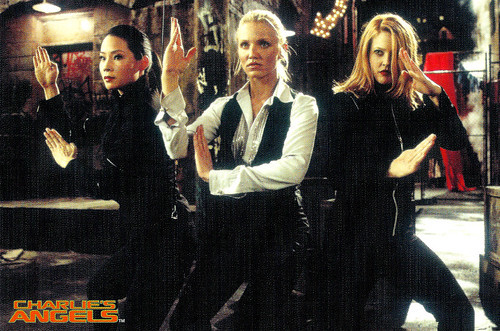
German postcard by ZigZag Posters, no. CA 09. Photo: Columbia. Lucy Liu, Cameron Diaz and Drew Barrymore in Charlie's Angels (McG, 2000).
The highest-paid actress over 40 in Hollywood
Cameron Diaz earned a third Golden Globe nomination for her supporting role in Vanilla Sky (Cameron Crowe, 2001) starring Tom Cruise and Penélope Cruz. She appeared in numerous high-profile films in the early 2000s, including Charlie's Angels (McG, 2000) with Drew Barrymore and Lucy Liu, and its sequel Charlie's Angels: Full Throttle (McG, 2003), as well as voicing the character of Princess Fiona in the Shrek series (2001–2010).
In 2003, she was cast opposite Leonardo DiCaprio and Daniel Day Lewis in the period epic Gangs of New York (Martin Scorsese, 2003), for which she earned her fourth Golden Globe nomination. Worldwide, the film grossed a total of US$ 193 million, while it was embraced by critics.
Her subsequent films included the dramatic comedies In Her Shoes (Curtis Hanson, 2005) with Toni Colette, and The Holiday (Nancy Meyers, 2006) with Kate Winslet , and the disappointing psychological thriller The Box (Richard Kelly, 2009). Diaz appeared in starring roles in the gross comedies The Other Woman (Nick Cassavetes, 2014) and Sex Tape (Jake Kasdan, 2014).
She tried to break out of her self-imposed prison of dumb blonde jokes but crashed with forgettable blockbusters such as Knight & Day (James Mangold, 2010) with Tom Cruise, and struggled as a cheetah-owning sociopath in Ridley Scott’s nonsensical thriller The Counsellor (2013). And then there were the duds Gambit (Michael Hoffman, 2012), and What to Expect When You’re Expecting (Kirk Jones, 2012).
She appeared in a new film adaptation of Annie (Will Gluck, 2014). For her part, Diaz was nominated for the Golden Raspberry Award for Worst Supporting Actress. Although the film received generally negative reviews, it managed to break even financially, grossing $133 million. Months after the film's release, Diaz confirmed she was formally retiring from acting, and she did not make a new film since.
Diaz wrote two health books: 'The Body Book' (2013), a New York Times bestseller, and 'The Longevity Book' (2016). In 2015, Cameron Diaz married her boyfriend of 8 months, Benji Madden. After appearing in There's Something About Mary (1998), Diaz briefly dated her co-star Matt Dillon. The following year, she began a four-year relationship with actor Jared Leto, which ended in 2003. Later, she dated singer and actor Justin Timberlake. They separated in 2007.
Her accolades include four Golden Globe Award nominations, three Screen Actors Guild Award nominations, and a New York Film Critics Award. In 2013, she was named the highest-paid actress over 40 in Hollywood. As of 2018, the U.S. domestic box office grosses of Diaz's films total over $3 billion USD, with worldwide grosses surpassing $7 billion, making her the fifth highest-grossing U.S. domestic box office actress.
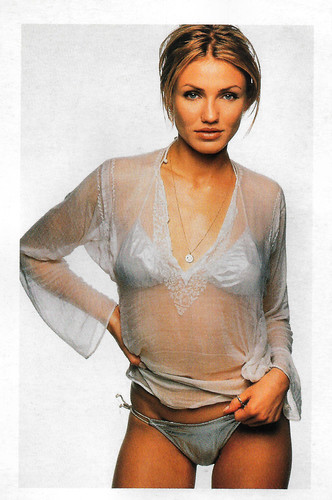
Belgian postcard in de 'De 50 mooiste vrouwen van de eeuw' (The 50 most beautiful women of the century) series by P magazine, no. 1. Photo: Mark Seuger / Outline.
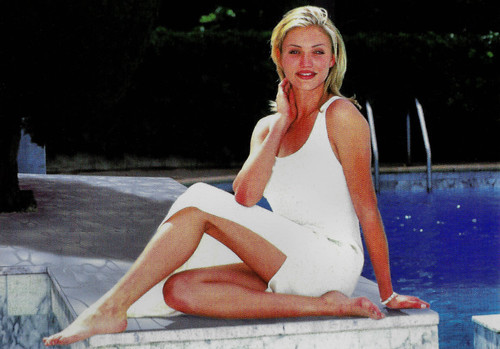
British postcard by Pyramid, Leicester, no PC 8228.
Sources: (IMDb), Wikipedia and .

British postcard by Heroes Publishing LTD., London, no. SPC 3328.

French postcard by Forum Cartes et Collections, Nouaillé, no. 35. Cannes (06), 2003. Photo: Anne-Christine Poujoulat-STF. Caption: The director Martin Scorsese (middle), the actor Leonardo DiCaprio (left) and the actress Cameron Diaz pose for the photographers before a screening of Gangs of New York on 20 May 2002 during the 55th Cannes Film Festival.

British postcard by Pyramid, Leicester, no. PC 2051.
An adventurous, independent and a tough kid
Cameron Diaz was born in 1972 in San Diego, California. She is the daughter of a Cuban-American father and an Anglo-German mother.
She graduated from Long Beach Polytechnic (Poly) High School (Class of 1990) in Long Beach, California. As a member of that school's 'Polyettes' dance-drill team, Cameron performed during half-time at football games. Self described as "adventurous, independent and a tough kid", she lived in such varied locales as Japan, Australia, Mexico, Morocco, and Paris.
Returning to California at the age of 21, Diaz was discovered by a photographer at a Hollywood party. He helped her land a contract with the Elite Modeling Agency. She was working as a model when she auditioned for a big part in the comedy The Mask (Chuck Russell, 1994), based on a Dark Horse comic book series of the same name.
To her amazement and despite having no previous acting experience, she was cast as the female lead in the film opposite Jim Carrey. It proved to be a great acting debut for her. The Mask is both a crazy comedy, which surpasses the imagination, but also works well as a thriller with a dark atmosphere.
Over the next 3 years, she honed her acting skills in such low budget independent films as The Last Supper (Stacy Title, 1995), Feeling Minnesota (Steven Baigelman, 1996) with Keanu Reeves , and Head Above Water (Jim Wilson, 1996) with Harvey Keitel.
She returned to main stream films in My Best Friend's Wedding (P.H. Hogan, 1997), in which she held her own against leading lady Julia Roberts. In 1998, she earned full fledged star status for her performance in the box office smash There's Something About Mary (Bobby Farrelly, Peter Farrelly, 1998) with Matt Dillon and Ben Stiller.
Her following two projects — the sports drama Any Given Sunday (Oliver Stone, 1999) starring Al Pacino, and Spike Jonze's surrealist fantasy Being John Malkovich (1999) — lent Diaz a reputation as a dramatic actress, the latter earning her her second Golden Globe nomination.

German postcard by ZigZag Posters, no. CA. 14. Photo: Columbia Pictures, 2000. Cameron Diaz as Natalie in Charlie's Angels (McG, 2000).

German postcard by ZigZag Posters, no. CA 09. Photo: Columbia. Lucy Liu, Cameron Diaz and Drew Barrymore in Charlie's Angels (McG, 2000).
The highest-paid actress over 40 in Hollywood
Cameron Diaz earned a third Golden Globe nomination for her supporting role in Vanilla Sky (Cameron Crowe, 2001) starring Tom Cruise and Penélope Cruz. She appeared in numerous high-profile films in the early 2000s, including Charlie's Angels (McG, 2000) with Drew Barrymore and Lucy Liu, and its sequel Charlie's Angels: Full Throttle (McG, 2003), as well as voicing the character of Princess Fiona in the Shrek series (2001–2010).
In 2003, she was cast opposite Leonardo DiCaprio and Daniel Day Lewis in the period epic Gangs of New York (Martin Scorsese, 2003), for which she earned her fourth Golden Globe nomination. Worldwide, the film grossed a total of US$ 193 million, while it was embraced by critics.
Her subsequent films included the dramatic comedies In Her Shoes (Curtis Hanson, 2005) with Toni Colette, and The Holiday (Nancy Meyers, 2006) with Kate Winslet , and the disappointing psychological thriller The Box (Richard Kelly, 2009). Diaz appeared in starring roles in the gross comedies The Other Woman (Nick Cassavetes, 2014) and Sex Tape (Jake Kasdan, 2014).
She tried to break out of her self-imposed prison of dumb blonde jokes but crashed with forgettable blockbusters such as Knight & Day (James Mangold, 2010) with Tom Cruise, and struggled as a cheetah-owning sociopath in Ridley Scott’s nonsensical thriller The Counsellor (2013). And then there were the duds Gambit (Michael Hoffman, 2012), and What to Expect When You’re Expecting (Kirk Jones, 2012).
She appeared in a new film adaptation of Annie (Will Gluck, 2014). For her part, Diaz was nominated for the Golden Raspberry Award for Worst Supporting Actress. Although the film received generally negative reviews, it managed to break even financially, grossing $133 million. Months after the film's release, Diaz confirmed she was formally retiring from acting, and she did not make a new film since.
Diaz wrote two health books: 'The Body Book' (2013), a New York Times bestseller, and 'The Longevity Book' (2016). In 2015, Cameron Diaz married her boyfriend of 8 months, Benji Madden. After appearing in There's Something About Mary (1998), Diaz briefly dated her co-star Matt Dillon. The following year, she began a four-year relationship with actor Jared Leto, which ended in 2003. Later, she dated singer and actor Justin Timberlake. They separated in 2007.
Her accolades include four Golden Globe Award nominations, three Screen Actors Guild Award nominations, and a New York Film Critics Award. In 2013, she was named the highest-paid actress over 40 in Hollywood. As of 2018, the U.S. domestic box office grosses of Diaz's films total over $3 billion USD, with worldwide grosses surpassing $7 billion, making her the fifth highest-grossing U.S. domestic box office actress.

Belgian postcard in de 'De 50 mooiste vrouwen van de eeuw' (The 50 most beautiful women of the century) series by P magazine, no. 1. Photo: Mark Seuger / Outline.

British postcard by Pyramid, Leicester, no PC 8228.
Sources: (IMDb), Wikipedia and .
Published on July 06, 2019 22:00
July 4, 2019
Corinne Griffith
Corinne Griffith (1894–1979) was dubbed 'The Orchid Lady of the Screen'. She was one of the most popular American film actresses of the 1920s and widely considered the most beautiful star of the silent screen. While she started out at Vitagraph in 1916, she became a very popular actress at First National Pictures. She was nominated for the Oscar for Best Actress for The Divine Lady (1929). When sound film set in, Griffith stopped acting and became a successful writer and businesswoman.

French postcard by Editions Cinémagazine, no. 19. Photo: First National. Corinne Griffith in The Divine Lady (Frank Lloyd, 1929).

German postcard by Ross Verlag, no. 3679/1, 1928-1929. Photo: Defina / First National. Corinne Griffith in The Divine Lady (Frank Lloyd, 1929).

German postcard by Ross Verlag, no. 3679/2, 1928-1929. Photo: Defina / First National. Corinne Griffith in The Divine Lady (Frank Lloyd, 1929).
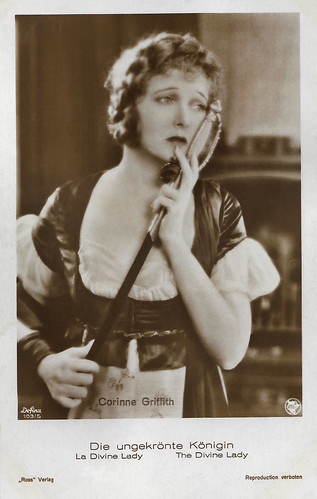
German postcard by Ross Verlag, no. 103/5, 1928-1929. Photo: Defina / First National. Corinne Griffith in The Divine Lady (Frank Lloyd, 1929).
A highly unusual character for the 1920s
Corinne Mae Griffith was born in 1896 in Texarkana, Texas, as the daughter of John Lewis Griffin, a Methodist minister, and Ambolina (Ambolyn) Ghio Griffin. She was educated in the Sacred Heart Convent school in New Orleans and worked as a dancer before she began her acting career.
She signed a studio contract with Vitagraph in 1916 and made quite a few films there, e.g. opposite the male lead at Vitagraph then, Earle Williams. By 1920 she had become a well-known film star herself at Vitagraph, known as 'The Orchid Lady of the Screen'.
Able to command her salaries, she left Vitagraph for First National Pictures in 1923, where her salaries were raised from 2.500 dollars a week in 1923 to 10.000 a week in 1927. In contrast to her ethereal screen image, Griffith negotiated each of her contracts personally and also personally dealt with the issue of her high salaries.
By the mid-1920s, she was considered Hollywood's richest woman next to Mary Pickford. In addition, already at Vitagraph, she could choose from three leading men and three directors. Also, she obtained decent working hours for herself on shooting days, which was uncommon in those years.
As Tom Slater writes in his biography on Women Film Pioneers Project , "A great beauty and comic talent, Griffith also played dramatic roles in which her character faced major decisions affecting her life and many others. Altogether, this body of work reveals the centrality and complexity of women’s roles in the post-Victorian consumer society.
In The Common Law (1923), Classified (1925), and The Garden of Eden (1928), directed by Lewis Milestone, Griffith must endure male lechery while attempting to earn a living and find romance. In Single Wives (1924), Déclassée (1925), and Three Hours (1927), she played wives involved in traumatic searches for love and meaning due to spousal abuse and neglect. In Black Oxen (1923), Griffith plays a highly unusual character for the twenties, or, indeed, probably any era, a woman who rejects romance for a political career."
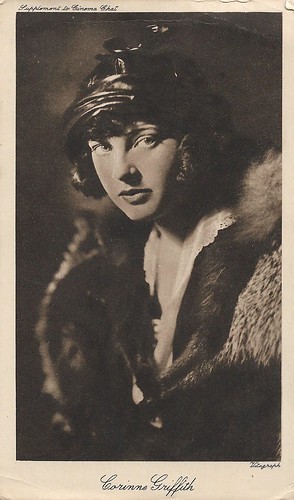
British postcard by Cinema Chat. Photo: Vitagraph.
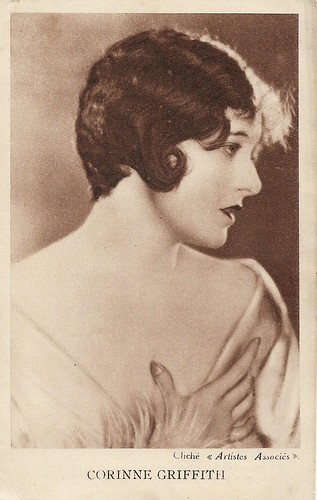
Belgian postcard by S. A. Cacao et Chocolat Kivou, Vilvorde / N. V. Cacao en Chocolade Kivou, Vilvoorde. Photo: United Artists.
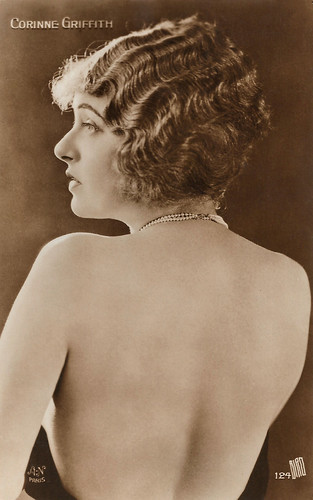
French postcard by A.N. (A. Noyer), Paris, no. 124. Photo: Bird. Corinne Griffith in Black Oxen (Frank Lloyd, 1923).
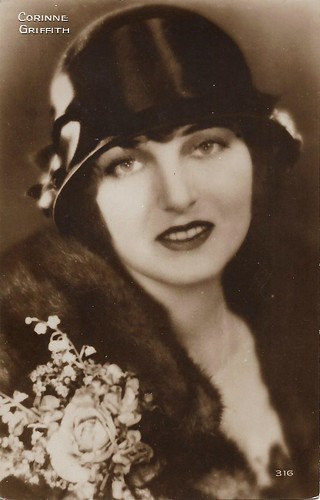
French postcard by Editions Cinémagazine, no. 316.

Danish postcard by Eneret, no. 725. Photo: First National. Corinne Griffith and Milton Sills in Single Wives (George Archainbaud, 1924).
A fabulous personal fortune
During her Vitagraph years, Corinne Griffith modestly lived at the Hotel des Artistes, while she would buy a large home when working at First National. Moreover, Slater reveals that in 1926, Griffith paid $185,000 for two properties in downtown Beverly Hills. This property would become the basis for a second career in real estate and a fabulous personal fortune.
By consequence, she became the first woman to address the National Realty Board in the early 1950s and campaigned throughout that decade to repeal the federal income tax. At one stage, Griffith owned four complete office buildings in Los Angeles.
She was the executive producer of eleven of her films starting with Single Wives (George Archainbaud, 1924) and ending with Three Hours (James Flood, 1927).
In 1929, Griffith was nominated for the Academy Award for Best Actress for her performance in Frank Lloyd's The Divine Lady (1929), a historical drama about the lives of Lady Emma Hamilton and Admiral Nelson.
This was an American Vitaphone sound film with a synchronised musical score, sound effects, and some synchronised singing, but no spoken dialogue. Griffith played the female lead of Lady Hamilton, opposite Victor Varconi as Horatio Nelson.
Anthony Slide argues in 'Silent Players' that The Divine Lady was even more fitted to end the silent film era than F. W. Murnau's masterpiece Sunrise (1928): "it is even better that silent film came to a close with the brilliant romanticism of Corinne Griffith's The Divine Lady, which is exemplary of the best in direction (by Frank Lloyd), scripting (by Agnes Christine Johnston), cinematography (by John Seitz), and above all is dominated by a lyrical performance of its star." Slide's assessment is supported by the fact that The Divine Lady received Oscars for photography and direction.
In 1930, Griffith's first real sound film, Lilies of the Field, (Alexander Korda, 1930) with Ralph Forbes , was released. Her voice did not record well and The New York Times stated that she "talked through her nose". The film was a box office flop, as was her next film, Back Pay (William A. Seiter, 1930). First National paid the actress $ 250,000 to terminate her contract with the studio.
Griffith made another film in the UK for Paramount-British Lily Christine (Paul L. Stein, 1932) opposite Colin Clive , and in 1935-1936, she did a theatre tour of Noël Coward 's 'Design for Living'. After the tour was finished, she retired from acting.
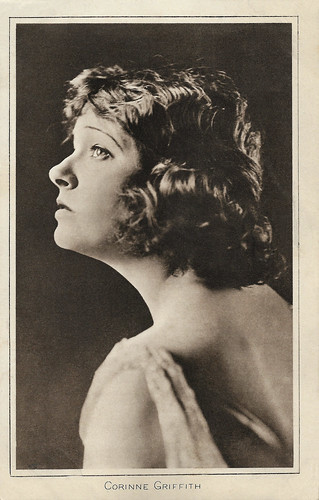
British postcard in the Pictures Potrait Gallery series by Pictures Ltd., London, no. 10/202. Sent by mail in 1931.
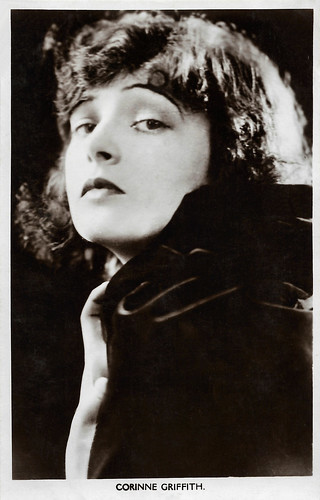
British postcard in the Picturegoer Series, London, no. 62.
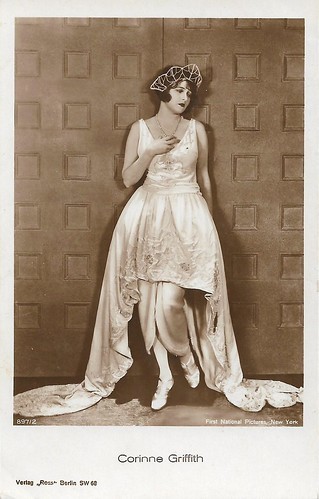
German postcard by Ross Verlag, Berlin, no. 897/2, 1925-1926. Photo: First National Pictures, New York.
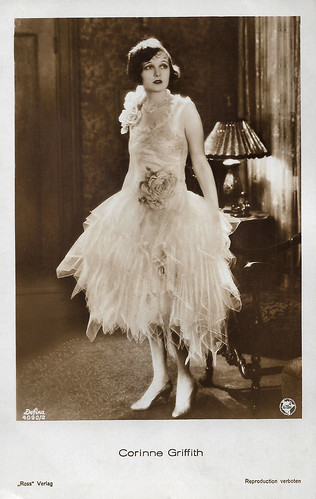
German postcard by Ross Verlag, no. 4090/2, 1929-1930. Photo: Defina / First National.
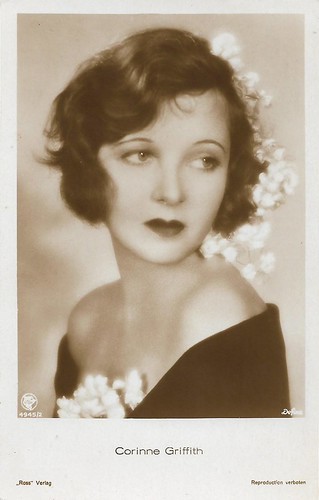
German postcard by Ross Verlag, no. 4945/2, 1929-1930. Photo: Defina / First National.
The real Corinne Griffith?
After 1936, Corinne Griffith focused on her real estate and her writing. In the late 1950s, she returned one more time to the screen in the last film by actor-producer-director Hugo Haas, the low-budget social commentary Stars in Your Own Backyard. It was released as Paradise Alley (Hugo Haas, 1961), and at IMDb , the few reviewers are very positive about the film and about Griffith's performance.
One of the 13 books she published was her biography: 'Papa's Delicate Condition'. In 1963, the book was filmed as Papa's Delicate Condition (George Marshall, 1963). Griffith was not fond of the film. In the credits, her name was misspelled as "Corrine Griffith". She had unsuccessfully campaigned for Fred Astaire to play her father and was disappointed with the choice of Jackie Gleason.
In addition, she wrote the text of 'Hail to the Redskins', the official hymn of the American football team the Washington Redskins, with whose owner George Preston Marshall she was married from 1936 to 1958. She described the experiences around the team in another bestseller, 'My Life with the Redskins'.
In the mid-1960s, Griffith's name reappeared in the headlines when she wanted to annul her short-term marriage with the 33-year-younger realtor and former Broadway actor Danny Scholl in court. During the process, she said that she was, in fact, the - at least 20 years younger and long-dead - sister of Corinne Griffith.
However, several colleagues from the silent film era, including Lois Wilson, Claire Windsor, and Betty Blythe, were able to prove in the course of the trial that the plaintiff would clearly be the real Corinne Griffith. Griffith pertained until her death she was her sister.
Griffith was married four times, first to her frequent co-star Vitagraph actor-director Webster Campbell (1920-1923). Then she mattied theatre producer Walter Morosco (1924-1934 or 1928-1934), who produced Lewis Milestone's The Garden of Eden, the sole film to come out of their short-lived joint production company Corinne Griffith Productions.
Her third husband was George Marshall (1936-1958), founder and longtime owner of the Washington Redskins. At the age of 71 she married realtor and Broadway actor Dan Scholl in 1965. They separated after six weeks and, following a messy and much publicised court battle, they were divorced. Griffith had no children of her own but had adopted two girls, Pamela and Cynthia.
Apart from real estate, she developed as a writer, painter, and composer. When she passed away in 1979, at her mansion in Bevely Hills, Corinne Griffith left behind an estate of about $ 150 million. A star on the Hollywood Walk of Fame, 1560 Wine Street, reminds of the actress.
Tom Tryon wrote a novella, Fedora, based on Griffith's claim that she had taken the place of the real actress. It was filmed by Billy Wilder as Fedora (1978) starring Hildegard Knef and Marthe Keller .
Sources: Anthony Slide (Silent Players), Tom Slater (Women Film Pioneers Project), Tim Lussier (Silents are Golden), Wikipedia (German and English), and .

French postcard by Editions Cinémagazine, no. 19. Photo: First National. Corinne Griffith in The Divine Lady (Frank Lloyd, 1929).

German postcard by Ross Verlag, no. 3679/1, 1928-1929. Photo: Defina / First National. Corinne Griffith in The Divine Lady (Frank Lloyd, 1929).

German postcard by Ross Verlag, no. 3679/2, 1928-1929. Photo: Defina / First National. Corinne Griffith in The Divine Lady (Frank Lloyd, 1929).

German postcard by Ross Verlag, no. 103/5, 1928-1929. Photo: Defina / First National. Corinne Griffith in The Divine Lady (Frank Lloyd, 1929).
A highly unusual character for the 1920s
Corinne Mae Griffith was born in 1896 in Texarkana, Texas, as the daughter of John Lewis Griffin, a Methodist minister, and Ambolina (Ambolyn) Ghio Griffin. She was educated in the Sacred Heart Convent school in New Orleans and worked as a dancer before she began her acting career.
She signed a studio contract with Vitagraph in 1916 and made quite a few films there, e.g. opposite the male lead at Vitagraph then, Earle Williams. By 1920 she had become a well-known film star herself at Vitagraph, known as 'The Orchid Lady of the Screen'.
Able to command her salaries, she left Vitagraph for First National Pictures in 1923, where her salaries were raised from 2.500 dollars a week in 1923 to 10.000 a week in 1927. In contrast to her ethereal screen image, Griffith negotiated each of her contracts personally and also personally dealt with the issue of her high salaries.
By the mid-1920s, she was considered Hollywood's richest woman next to Mary Pickford. In addition, already at Vitagraph, she could choose from three leading men and three directors. Also, she obtained decent working hours for herself on shooting days, which was uncommon in those years.
As Tom Slater writes in his biography on Women Film Pioneers Project , "A great beauty and comic talent, Griffith also played dramatic roles in which her character faced major decisions affecting her life and many others. Altogether, this body of work reveals the centrality and complexity of women’s roles in the post-Victorian consumer society.
In The Common Law (1923), Classified (1925), and The Garden of Eden (1928), directed by Lewis Milestone, Griffith must endure male lechery while attempting to earn a living and find romance. In Single Wives (1924), Déclassée (1925), and Three Hours (1927), she played wives involved in traumatic searches for love and meaning due to spousal abuse and neglect. In Black Oxen (1923), Griffith plays a highly unusual character for the twenties, or, indeed, probably any era, a woman who rejects romance for a political career."

British postcard by Cinema Chat. Photo: Vitagraph.

Belgian postcard by S. A. Cacao et Chocolat Kivou, Vilvorde / N. V. Cacao en Chocolade Kivou, Vilvoorde. Photo: United Artists.

French postcard by A.N. (A. Noyer), Paris, no. 124. Photo: Bird. Corinne Griffith in Black Oxen (Frank Lloyd, 1923).

French postcard by Editions Cinémagazine, no. 316.

Danish postcard by Eneret, no. 725. Photo: First National. Corinne Griffith and Milton Sills in Single Wives (George Archainbaud, 1924).
A fabulous personal fortune
During her Vitagraph years, Corinne Griffith modestly lived at the Hotel des Artistes, while she would buy a large home when working at First National. Moreover, Slater reveals that in 1926, Griffith paid $185,000 for two properties in downtown Beverly Hills. This property would become the basis for a second career in real estate and a fabulous personal fortune.
By consequence, she became the first woman to address the National Realty Board in the early 1950s and campaigned throughout that decade to repeal the federal income tax. At one stage, Griffith owned four complete office buildings in Los Angeles.
She was the executive producer of eleven of her films starting with Single Wives (George Archainbaud, 1924) and ending with Three Hours (James Flood, 1927).
In 1929, Griffith was nominated for the Academy Award for Best Actress for her performance in Frank Lloyd's The Divine Lady (1929), a historical drama about the lives of Lady Emma Hamilton and Admiral Nelson.
This was an American Vitaphone sound film with a synchronised musical score, sound effects, and some synchronised singing, but no spoken dialogue. Griffith played the female lead of Lady Hamilton, opposite Victor Varconi as Horatio Nelson.
Anthony Slide argues in 'Silent Players' that The Divine Lady was even more fitted to end the silent film era than F. W. Murnau's masterpiece Sunrise (1928): "it is even better that silent film came to a close with the brilliant romanticism of Corinne Griffith's The Divine Lady, which is exemplary of the best in direction (by Frank Lloyd), scripting (by Agnes Christine Johnston), cinematography (by John Seitz), and above all is dominated by a lyrical performance of its star." Slide's assessment is supported by the fact that The Divine Lady received Oscars for photography and direction.
In 1930, Griffith's first real sound film, Lilies of the Field, (Alexander Korda, 1930) with Ralph Forbes , was released. Her voice did not record well and The New York Times stated that she "talked through her nose". The film was a box office flop, as was her next film, Back Pay (William A. Seiter, 1930). First National paid the actress $ 250,000 to terminate her contract with the studio.
Griffith made another film in the UK for Paramount-British Lily Christine (Paul L. Stein, 1932) opposite Colin Clive , and in 1935-1936, she did a theatre tour of Noël Coward 's 'Design for Living'. After the tour was finished, she retired from acting.

British postcard in the Pictures Potrait Gallery series by Pictures Ltd., London, no. 10/202. Sent by mail in 1931.

British postcard in the Picturegoer Series, London, no. 62.

German postcard by Ross Verlag, Berlin, no. 897/2, 1925-1926. Photo: First National Pictures, New York.

German postcard by Ross Verlag, no. 4090/2, 1929-1930. Photo: Defina / First National.

German postcard by Ross Verlag, no. 4945/2, 1929-1930. Photo: Defina / First National.
The real Corinne Griffith?
After 1936, Corinne Griffith focused on her real estate and her writing. In the late 1950s, she returned one more time to the screen in the last film by actor-producer-director Hugo Haas, the low-budget social commentary Stars in Your Own Backyard. It was released as Paradise Alley (Hugo Haas, 1961), and at IMDb , the few reviewers are very positive about the film and about Griffith's performance.
One of the 13 books she published was her biography: 'Papa's Delicate Condition'. In 1963, the book was filmed as Papa's Delicate Condition (George Marshall, 1963). Griffith was not fond of the film. In the credits, her name was misspelled as "Corrine Griffith". She had unsuccessfully campaigned for Fred Astaire to play her father and was disappointed with the choice of Jackie Gleason.
In addition, she wrote the text of 'Hail to the Redskins', the official hymn of the American football team the Washington Redskins, with whose owner George Preston Marshall she was married from 1936 to 1958. She described the experiences around the team in another bestseller, 'My Life with the Redskins'.
In the mid-1960s, Griffith's name reappeared in the headlines when she wanted to annul her short-term marriage with the 33-year-younger realtor and former Broadway actor Danny Scholl in court. During the process, she said that she was, in fact, the - at least 20 years younger and long-dead - sister of Corinne Griffith.
However, several colleagues from the silent film era, including Lois Wilson, Claire Windsor, and Betty Blythe, were able to prove in the course of the trial that the plaintiff would clearly be the real Corinne Griffith. Griffith pertained until her death she was her sister.
Griffith was married four times, first to her frequent co-star Vitagraph actor-director Webster Campbell (1920-1923). Then she mattied theatre producer Walter Morosco (1924-1934 or 1928-1934), who produced Lewis Milestone's The Garden of Eden, the sole film to come out of their short-lived joint production company Corinne Griffith Productions.
Her third husband was George Marshall (1936-1958), founder and longtime owner of the Washington Redskins. At the age of 71 she married realtor and Broadway actor Dan Scholl in 1965. They separated after six weeks and, following a messy and much publicised court battle, they were divorced. Griffith had no children of her own but had adopted two girls, Pamela and Cynthia.
Apart from real estate, she developed as a writer, painter, and composer. When she passed away in 1979, at her mansion in Bevely Hills, Corinne Griffith left behind an estate of about $ 150 million. A star on the Hollywood Walk of Fame, 1560 Wine Street, reminds of the actress.
Tom Tryon wrote a novella, Fedora, based on Griffith's claim that she had taken the place of the real actress. It was filmed by Billy Wilder as Fedora (1978) starring Hildegard Knef and Marthe Keller .
Sources: Anthony Slide (Silent Players), Tom Slater (Women Film Pioneers Project), Tim Lussier (Silents are Golden), Wikipedia (German and English), and .
Published on July 04, 2019 22:00
July 3, 2019
Elli Parvo
Elli Parvo (1914–2010) was an Italian screen actress between the mid-1930s and 1960 and known as 'the woman men fight over' as in Desiderio (1943-1945) or 'the femme fatale' as in Il sole sorge ancora (1946).
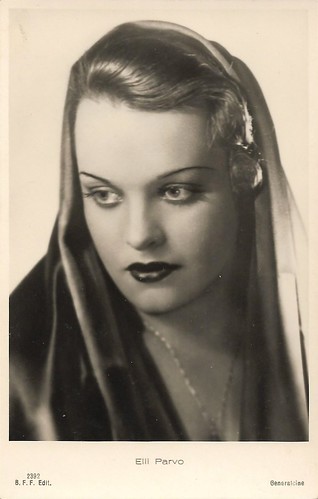
Italian postcard by Ballerini & Fratini Editori, Florence, no. 2392. Photo: Generalcine.
Mundane, lush ladies of loose morals
Elli Parvo, an anagram of her real name Elvira Gobbo, was born in Milan, in 1914. Her father was from Friuli, her mother from Berlin.
Elli was educated in a Swiss school in her native town. She debuted at the age of 19 as an extra in the period piece Teresa Confalonieri/Loyalty of Love (1934) by Guido Brignone. Several bit parts followed.
From 1937, she also had major roles in Italian films, as in the comedy Lasciate ogni speranza/Abandon all hope (Gennaro Righelli, 1937) with Antonio Gandusio, Gatta ci cova/Cat cats us (Gennaro Righelli, 1937) with Angelo Musco, Mia moglie si diverte, the Italian version of the multiversion film Unsere kleine Frau/Our Little Wife (Paul Verhoeven, 1938) with Käthe von Nagy , Il marchese di Ruvolito/The Marquis of Ruvolo (Raffaele Matarazzo, 1939) with Eduardo and Peppino De Filippo , and La notte delle beffe/The Night of Tricks (Carlo Campogalliani, 1939) with Amedeo Nazzari and Dria Paola .
During the first war years, Parvo was most active in film, acting in about six films per year. In La donna perduta/The lost woman (Domenico Gambino, 1940), she had the lead, opposite a range of former actors of the silent screen including Alberto Capozzi , Mary Cléo Tarlarini and Oreste Bilancia .
She appeared in Ridi pagliaccio/Laugh clown (Camillo Mastrocinque, 1941) with Fosco Giacchetti and Laura Solari , and played the lead in L’allegro fantasma/The Happy Ghost (Amleto Palermi, 1941) with Totò.
Parvo often played either cheeky maids as in Sette anni di felicità/Seven Years of Happiness (Ernst Marischka, Roberto Savarese, 1942) and its German version, Sieben Jahre Glück (Ernst Marischka, 1942) – both shot at Cinecittà, or mundane, lush ladies of loose morals, such as Angela, the girlfriend of Francesca Cenci in Beatrice Cenci (Guido Brignone, 1941) featuring Carola Höhn .
Her other films from the war years include I due Foscari/The two Foscari (Enrico Fulchignoni, 1942), Il fanciullo del West/The child of the West (Giorgio Ferroni, 1942) with Macario – considered the first Italian Western parody, Carmen (Christian-Jaque, 1943) with Viviance Romance , and La porta del cielo/The Gates of Heaven (Vittorio De Sica, 1944).
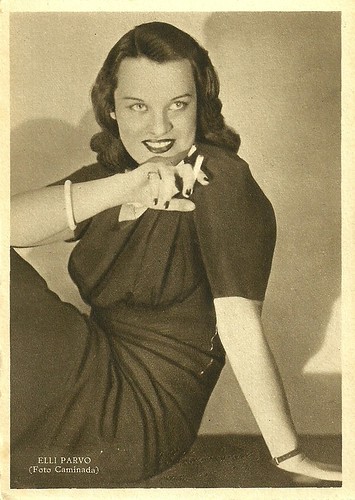
Italian postcard by Rizzoli & Co., Milan, 1940. Photo: Caminada.
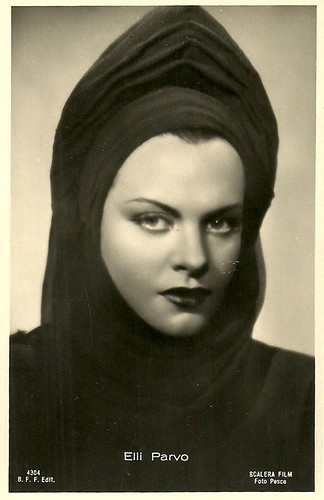
Italian postcard by Ballerini & Fratini Editori, Florence, no. 4304. Photo: Pesce /Scalera Film. Parvo's outfit is that of I due Foscari (Enrico Fulchignoni, 1942).
Not afraid of showing as much of her body as could be
"Gorgeous, dark-haired, luscious-lipped, shapely-legged, not afraid of showing as much of her body as could be, Elli Parvo was THE femme fatale of post-war Italy", writes Guy Bellinger at IMDb .
She got this repuataion with the female lead in Desiderio (Marcello Pagliero, 1946). The film was started by Roberto Rossellini in 1943 as Scalo merci/Goods terminal, but finished by Pagliero. The film tells the tragic story of Paola, a woman who hides her former life as prostitute for Giovanni, an honest man ( Carlo Ninchi ) who wants to marry her. Returned to her village and family because of her sister’s wedding, he follows her, so in the end three men rival for her: her lover, her brother-in-law and an evil former lover. She cannot cope with this and kills herself. The film was quickly taken out of release and cut back by the censors, partly for having shown Parvo bare-breasted.
Also released in 1946 was the classic Neorealist film Il sole sorge ancora/Outcry, directed by her husband Aldo Vergano. Here Parvo played Matilde, a wealthy estate owner who, towards the end of the war in Italy, seduces the male lead, the ex-soldier Cesare (Vittorio Duse), who has returned to his village, finding it filled with displaced persons.
More femme fatale parts followed in the rural dramas Legge di sangue/Blood law (Luigi Capuano, 1948) with Leonardo Cortese and Luigi Tosi, Vertigine d'amore/Vertigo of love (Luigi Capuano, 1949) with Charles Vanel and Folco Lulli , and Santo disonore/Dishonored (Guido Brignone, 1950) with men constantly fighting about her.
Parvo also acted in two comedies by Luigi Zampa: È più facile che un cammello.../Twelve Hours to Live (1950) with Jean Gabin , and L'arte di arrangiarsi/The Art of Getting Along (1954) with Alberto Sordi .
In the mid-fifties Parvo’s career went into decline, when her femme fatale-like characters became less in demand. Her only important participation was a parody of her stereotype, alongside Totò , in Totò terzo uomo/Toto the Third Man (1951), by Mario Mattoli. She can also be seen in a bit part in Antonioni's heart-rending Il grido (Michelangelo Antonioni, 1957). In 1960, after playing a small role in Madri pericolose/Dangerous Mothers (Domenico Paolella, 1960), Parvo retired.
Elli Parvo died in 2010 in Rome, at the high age of 94.
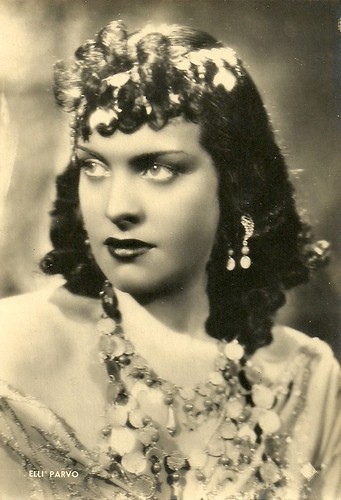
Italian postcard by ASER (A. Scaramaglia Edizioni, Roma), no. 82. Photo: Pesce.
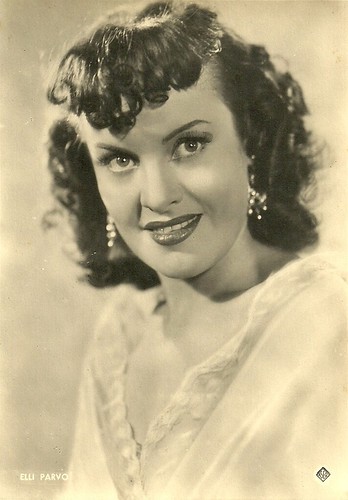
Italian postcard by ASER (A. Scaramaglia Edizioni, Roma), no. 141. Photo: Atlas Tirrenia.
Sources: (IMDb), Wikipedia and .

Italian postcard by Ballerini & Fratini Editori, Florence, no. 2392. Photo: Generalcine.
Mundane, lush ladies of loose morals
Elli Parvo, an anagram of her real name Elvira Gobbo, was born in Milan, in 1914. Her father was from Friuli, her mother from Berlin.
Elli was educated in a Swiss school in her native town. She debuted at the age of 19 as an extra in the period piece Teresa Confalonieri/Loyalty of Love (1934) by Guido Brignone. Several bit parts followed.
From 1937, she also had major roles in Italian films, as in the comedy Lasciate ogni speranza/Abandon all hope (Gennaro Righelli, 1937) with Antonio Gandusio, Gatta ci cova/Cat cats us (Gennaro Righelli, 1937) with Angelo Musco, Mia moglie si diverte, the Italian version of the multiversion film Unsere kleine Frau/Our Little Wife (Paul Verhoeven, 1938) with Käthe von Nagy , Il marchese di Ruvolito/The Marquis of Ruvolo (Raffaele Matarazzo, 1939) with Eduardo and Peppino De Filippo , and La notte delle beffe/The Night of Tricks (Carlo Campogalliani, 1939) with Amedeo Nazzari and Dria Paola .
During the first war years, Parvo was most active in film, acting in about six films per year. In La donna perduta/The lost woman (Domenico Gambino, 1940), she had the lead, opposite a range of former actors of the silent screen including Alberto Capozzi , Mary Cléo Tarlarini and Oreste Bilancia .
She appeared in Ridi pagliaccio/Laugh clown (Camillo Mastrocinque, 1941) with Fosco Giacchetti and Laura Solari , and played the lead in L’allegro fantasma/The Happy Ghost (Amleto Palermi, 1941) with Totò.
Parvo often played either cheeky maids as in Sette anni di felicità/Seven Years of Happiness (Ernst Marischka, Roberto Savarese, 1942) and its German version, Sieben Jahre Glück (Ernst Marischka, 1942) – both shot at Cinecittà, or mundane, lush ladies of loose morals, such as Angela, the girlfriend of Francesca Cenci in Beatrice Cenci (Guido Brignone, 1941) featuring Carola Höhn .
Her other films from the war years include I due Foscari/The two Foscari (Enrico Fulchignoni, 1942), Il fanciullo del West/The child of the West (Giorgio Ferroni, 1942) with Macario – considered the first Italian Western parody, Carmen (Christian-Jaque, 1943) with Viviance Romance , and La porta del cielo/The Gates of Heaven (Vittorio De Sica, 1944).

Italian postcard by Rizzoli & Co., Milan, 1940. Photo: Caminada.

Italian postcard by Ballerini & Fratini Editori, Florence, no. 4304. Photo: Pesce /Scalera Film. Parvo's outfit is that of I due Foscari (Enrico Fulchignoni, 1942).
Not afraid of showing as much of her body as could be
"Gorgeous, dark-haired, luscious-lipped, shapely-legged, not afraid of showing as much of her body as could be, Elli Parvo was THE femme fatale of post-war Italy", writes Guy Bellinger at IMDb .
She got this repuataion with the female lead in Desiderio (Marcello Pagliero, 1946). The film was started by Roberto Rossellini in 1943 as Scalo merci/Goods terminal, but finished by Pagliero. The film tells the tragic story of Paola, a woman who hides her former life as prostitute for Giovanni, an honest man ( Carlo Ninchi ) who wants to marry her. Returned to her village and family because of her sister’s wedding, he follows her, so in the end three men rival for her: her lover, her brother-in-law and an evil former lover. She cannot cope with this and kills herself. The film was quickly taken out of release and cut back by the censors, partly for having shown Parvo bare-breasted.
Also released in 1946 was the classic Neorealist film Il sole sorge ancora/Outcry, directed by her husband Aldo Vergano. Here Parvo played Matilde, a wealthy estate owner who, towards the end of the war in Italy, seduces the male lead, the ex-soldier Cesare (Vittorio Duse), who has returned to his village, finding it filled with displaced persons.
More femme fatale parts followed in the rural dramas Legge di sangue/Blood law (Luigi Capuano, 1948) with Leonardo Cortese and Luigi Tosi, Vertigine d'amore/Vertigo of love (Luigi Capuano, 1949) with Charles Vanel and Folco Lulli , and Santo disonore/Dishonored (Guido Brignone, 1950) with men constantly fighting about her.
Parvo also acted in two comedies by Luigi Zampa: È più facile che un cammello.../Twelve Hours to Live (1950) with Jean Gabin , and L'arte di arrangiarsi/The Art of Getting Along (1954) with Alberto Sordi .
In the mid-fifties Parvo’s career went into decline, when her femme fatale-like characters became less in demand. Her only important participation was a parody of her stereotype, alongside Totò , in Totò terzo uomo/Toto the Third Man (1951), by Mario Mattoli. She can also be seen in a bit part in Antonioni's heart-rending Il grido (Michelangelo Antonioni, 1957). In 1960, after playing a small role in Madri pericolose/Dangerous Mothers (Domenico Paolella, 1960), Parvo retired.
Elli Parvo died in 2010 in Rome, at the high age of 94.

Italian postcard by ASER (A. Scaramaglia Edizioni, Roma), no. 82. Photo: Pesce.

Italian postcard by ASER (A. Scaramaglia Edizioni, Roma), no. 141. Photo: Atlas Tirrenia.
Sources: (IMDb), Wikipedia and .
Published on July 03, 2019 22:00
July 2, 2019
Das goldene Kalb (1924)
The German silent drama Das goldene Kalb
/The Golden Calf
(1924) by Peter Paul Felner has an all-star cast with Henny Porten, Albert Steinrück, Olga Engl, Rosa Valetti, Angelo Ferrari, Colette Brettel, Johannes Riemann and the Russian actor Ossip Runitsch. However, the postcards by Ross Verlag all focus on Henny Porten, and her love interest in the film, the Italian Angelo Ferrari.
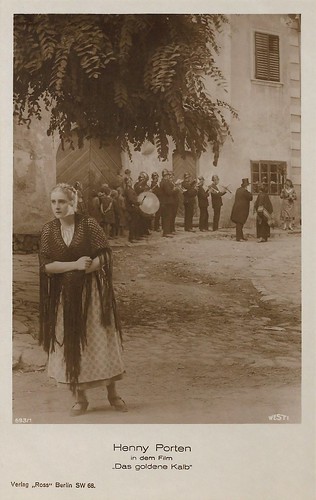
German postcard by Ross Verlag, no. 593/1. Photo: Westi-Film, Berlin. Henny Porten in Das goldene Kalb (Peter Paul Felner, 1924).
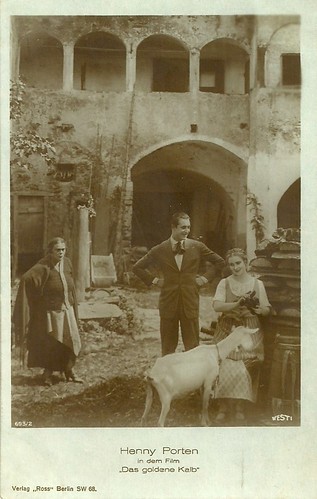
German postcard by Ross Verlag, no. 593/2. Photo: Westi-Film, Berlin. Henny Porten and Angelo Ferrari in Das goldene Kalb (Peter Paul Felner, 1924). The woman on the left is Rosa Valetti.
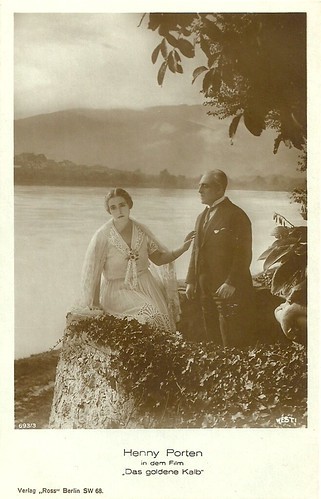
German postcard by Ross Verlag, no. 593/3. Photo: Westi-Film, Berlin. Henny Porten in Das goldene Kalb (Peter Paul Felner, 1924).
Dividing the Golden Calf in two
In Das goldene Kalb/The Golden Calf (1924), the female owner of a large fortune should, according to the wishes of her father, leave only one of her two grandchildren - two boys - the entire property. The woman decides to give the whole heir to one grandchild.
Then she is tormented by a vision and sees the granddaughter of the other, disadvantaged grandchild will once grow up as an orphan. The girl will fall into the hands of an unscrupulous adventurer and end up on the gallows.
To prevent this terrible fate, the old lady now decides to favour the other grandchild. But this decision proves to be fatal in a second vision: for now, the grandson of the disinherited will become a criminal and also land under the gallows.
The testator decides, therefore, against the desire of her own father, to the only true, Solomonic solution: she divides the heritage, the 'golden calf', into two equal parts and thus follows her sense of justice.
Das goldene Kalb/The Golden Calf was shot in the autumn of 1924. The exterior shots were taken near Dürnstein. Otto Erdmann and Hans Sohnle created the film sets. Eugen Kürschner was the location manager.
Das goldene Kalb passed the film censorship on 15 December 1924. It premiered on 30 January 1925, in Vienna, where it was banned from schools. The German premiere took place on 17 April 1925, in the Alhambra cinema on Berlin's Kurfürstendamm.
Paimann's Filmliste state: "The subject is interestingly worked, in the director's afloat, the presentation in all roles very well, Henny Porten especially in some scenes of the first action interesting, where she managed to get rid of the usual template. Featuring and photos are sour work, the latter noteworthy, especially in the beautiful outdoor scenes near Dürnstein.
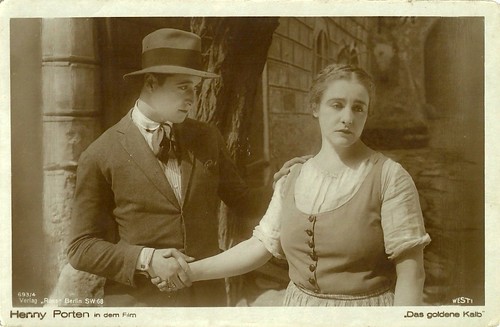
German postcard by Ross Verlag, no. 593/4. Photo: Westi-Film, Berlin. Henny Porten and Angelo Ferrari in Das goldene Kalb (Peter Paul Felner, 1924).
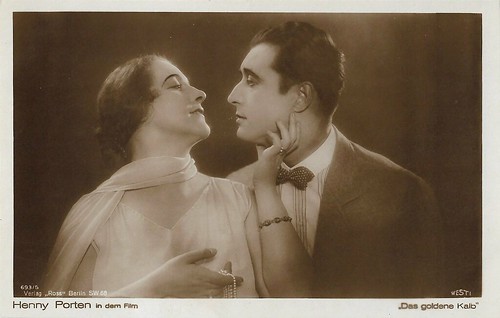
German postcard by Ross Verlag, no. 593/5. Photo: Westi-Film, Berlin. Henny Porten and Angelo Ferrari in Das goldene Kalb (Peter Paul Felner, 1924).
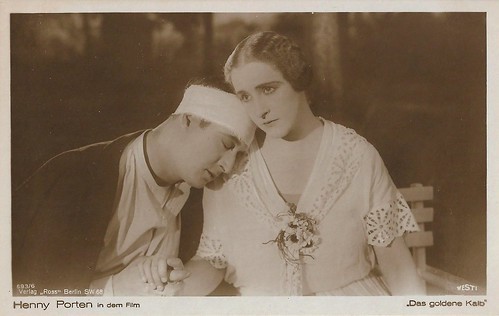
German postcard by Ross Verlag, no. 593/6. Photo: Westi-Film, Berlin. Henny Porten and Angelo Ferrari in Das goldene Kalb (Peter Paul Felner, 1924).
Sources: Wikipedia (German), Filmportal.de, and IMDb.

German postcard by Ross Verlag, no. 593/1. Photo: Westi-Film, Berlin. Henny Porten in Das goldene Kalb (Peter Paul Felner, 1924).

German postcard by Ross Verlag, no. 593/2. Photo: Westi-Film, Berlin. Henny Porten and Angelo Ferrari in Das goldene Kalb (Peter Paul Felner, 1924). The woman on the left is Rosa Valetti.

German postcard by Ross Verlag, no. 593/3. Photo: Westi-Film, Berlin. Henny Porten in Das goldene Kalb (Peter Paul Felner, 1924).
Dividing the Golden Calf in two
In Das goldene Kalb/The Golden Calf (1924), the female owner of a large fortune should, according to the wishes of her father, leave only one of her two grandchildren - two boys - the entire property. The woman decides to give the whole heir to one grandchild.
Then she is tormented by a vision and sees the granddaughter of the other, disadvantaged grandchild will once grow up as an orphan. The girl will fall into the hands of an unscrupulous adventurer and end up on the gallows.
To prevent this terrible fate, the old lady now decides to favour the other grandchild. But this decision proves to be fatal in a second vision: for now, the grandson of the disinherited will become a criminal and also land under the gallows.
The testator decides, therefore, against the desire of her own father, to the only true, Solomonic solution: she divides the heritage, the 'golden calf', into two equal parts and thus follows her sense of justice.
Das goldene Kalb/The Golden Calf was shot in the autumn of 1924. The exterior shots were taken near Dürnstein. Otto Erdmann and Hans Sohnle created the film sets. Eugen Kürschner was the location manager.
Das goldene Kalb passed the film censorship on 15 December 1924. It premiered on 30 January 1925, in Vienna, where it was banned from schools. The German premiere took place on 17 April 1925, in the Alhambra cinema on Berlin's Kurfürstendamm.
Paimann's Filmliste state: "The subject is interestingly worked, in the director's afloat, the presentation in all roles very well, Henny Porten especially in some scenes of the first action interesting, where she managed to get rid of the usual template. Featuring and photos are sour work, the latter noteworthy, especially in the beautiful outdoor scenes near Dürnstein.

German postcard by Ross Verlag, no. 593/4. Photo: Westi-Film, Berlin. Henny Porten and Angelo Ferrari in Das goldene Kalb (Peter Paul Felner, 1924).

German postcard by Ross Verlag, no. 593/5. Photo: Westi-Film, Berlin. Henny Porten and Angelo Ferrari in Das goldene Kalb (Peter Paul Felner, 1924).

German postcard by Ross Verlag, no. 593/6. Photo: Westi-Film, Berlin. Henny Porten and Angelo Ferrari in Das goldene Kalb (Peter Paul Felner, 1924).
Sources: Wikipedia (German), Filmportal.de, and IMDb.
Published on July 02, 2019 22:00
July 1, 2019
Zizi Jeanmaire
Glamorous ballet dancer and film star Zizi Jeanmaire (1924) became famous in the 1950s after playing the title role in the ballet version of Carmen, produced in London in 1949. She went on to appear in films in France and Hollywood. She is the widow of dancer and choreographer Roland Petit, one of the major creative forces in ballet during the 1940s and 1950s.
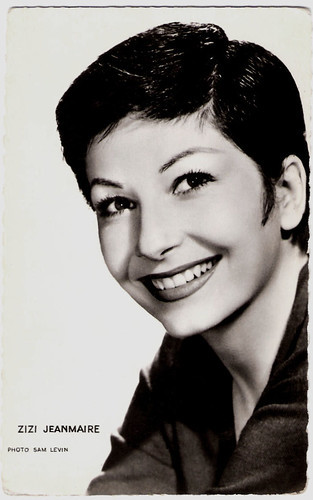
French postcard by Editions P.I., Paris, no. 797. Photo: Sam Lévin.
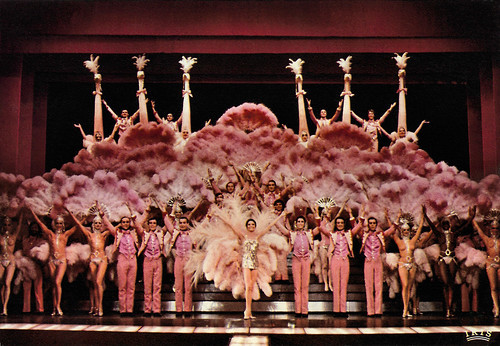
French postcard by Iris / Editions Chantal, Paris, no. 455. Caption: Le tableau final de la revue du Casino de Paris. (The final picture of the stage production 'Revue' at the Casino de Paris.)
Erotic Frankness in Dance
Renée Marcelle Jeanmaire was born in Paris, France, in 1924.
At the age of nine, she entered the Paris Opéra Ballet school in 1933, where she would meet her future husband and long-time collaborator Roland Petit.
In 1940, she was engaged in the corps de ballet. In 1944, Renée Jeanmaire quited the Paris Opera House to work with Les Ballets de Monte Carlo. She briefly joined Petit’s new company, Les Ballets des Champs-Elysées in 1946, and reunited with him at Les Ballets de Paris in 1949.
Petit defined a new French chic and erotic frankness in dance, and Jeanmaire became his muse and prima ballerina. Petit reinvented the suffering, virginal ballerina as a provocative, irresistible femme fatale of the modern day. Two of their most famous ballets were Le jeune homme et la mort (The Young Man and the Death) and Carmen, with Jeanmaire as the lethal female destroying a hapless male in both.
In its 2011 obituary of Petit, The Telegraph candidly recalled: “Petit created Carmen, an encapsulation of Bizet's opera in ballet, which premiered in 1949 at the Prince's Theatre, Shaftesbury Avenue, and became an instant world hit. Jeanmaire bobbed her hair short and wore a scant black corset, which, coupled with the candid seductiveness of her pas de deux with Petit, caused both shock and delight among the crowds who rushed to see it. One observer commented that he could see men's trouser buttons popping during the performance.“
Their ballets caused a sensation worldwide and Petit and Jeanmaire (now Zizi Jeanmaire) swiftly became the most exciting names in French dance. Samuel Goldwyn invited them to come to Hollywood for the choreography and leading lady role in the fantasy Hans Christian Andersen (Charles Vidor, 1952) starring Danny Kaye as the famous Danish fairytale writer.
In 1954 Petit and Jeanmaire married.
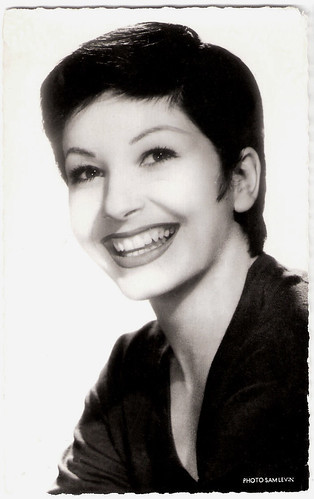
French postcard by Editions du Globe, Paris, no. 615. Photo: Sam Lévin.
Reinventing the Paris Revue
When Roland Petit and Zizi Jeanmaire toured the Ballets de Paris through the U.S. in 1955 they were showered with Hollywood invitations. To Jeanmaire's chagrin, Petit chose a younger lookalike, Leslie Caron , to be the lead in his Fred Astaire musical Daddy Long Legs (Jean Negulesco, 1955).
Jeanmaire did appear in Petit’s Anything Goes (Robert Lewis, 1956) with Bing Crosby, but her Hollywood stint was brief. She returned to France to appear in such musicals as Folies-Bergère (Henri Decoin, 1956) with Eddie Constantine and choreography by Petit. In this film she first sang her hit song Mon truc en plumes (My Feather Trick).
Petit also choreographed 1-2-3-4 ou Les Collants noirs/Black Tights (Terence Young, 1960) to show Zizi Jeanmaire's magnetic balletic gifts alongside Cyd Charisse and Moira Shearer .
Petit then created La Revue des Ballets de Paris and set about reinventing the Paris revue around his wife, exploring new levels of luxury and sophistication for her many talents. Not only did Jeanmaire dance like an angel in any style, dressed flamboyantly (and sometimes minimally) by costumiers such as Erté, but she possessed an alluring singing voice and a worldly verbal wit that sold countless records.
In 1970, Petit accepted to take the direction of the Paris Opera ballet, but he resigned after only six months. He bought Le Casino de Paris to create two musicals: 'La Revue' and 'Zizi je t’aime', with scenery and costumes from Erté, Yves Saint Laurent, Vasarély, Guy Pellaert, and César. Lyrics are by Jean-Jacques Debout, Guy Béart, Jean Férrat, Michel Legrand, and Serge Gainsbourg . The result was a supercharged new kind of music-hall, in which Zizi was the centre. In 1976, in spite of the big success, the tax burden forced Roland Petit and Zizi Jeanmaire to give up Le Casino de Paris.
During her career, Zizi Jeanmaire produced more than 60 shows with Petit. She was honoured to be Chevalier des arts et des lettres (in 1962), Chevalier de la légion d’honneur (1974), Officier de l’ordre national du mérite (1983), Officier de la Légion d’honneur (1993), and Commandeur de l’ordre national du mérite (1997).
Roland Petit passed away in 2011. He and Zizi had one daughter, Valentine Petit, a dancer and actress. Zizi Jeanmaire lives in Geneva, Switzerland.
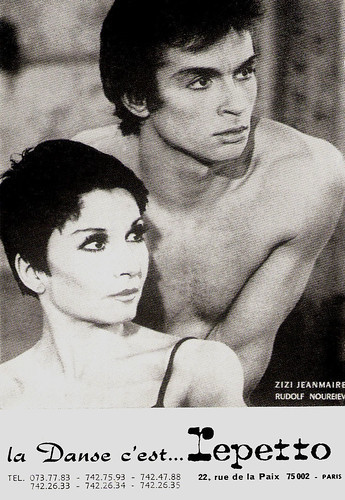
French postcard by Repetto, Paris. Photo: Studio Mardyks.
Sources: Official Roland Petit site, The Telegraph, Wikipedia (English and French) and .

French postcard by Editions P.I., Paris, no. 797. Photo: Sam Lévin.

French postcard by Iris / Editions Chantal, Paris, no. 455. Caption: Le tableau final de la revue du Casino de Paris. (The final picture of the stage production 'Revue' at the Casino de Paris.)
Erotic Frankness in Dance
Renée Marcelle Jeanmaire was born in Paris, France, in 1924.
At the age of nine, she entered the Paris Opéra Ballet school in 1933, where she would meet her future husband and long-time collaborator Roland Petit.
In 1940, she was engaged in the corps de ballet. In 1944, Renée Jeanmaire quited the Paris Opera House to work with Les Ballets de Monte Carlo. She briefly joined Petit’s new company, Les Ballets des Champs-Elysées in 1946, and reunited with him at Les Ballets de Paris in 1949.
Petit defined a new French chic and erotic frankness in dance, and Jeanmaire became his muse and prima ballerina. Petit reinvented the suffering, virginal ballerina as a provocative, irresistible femme fatale of the modern day. Two of their most famous ballets were Le jeune homme et la mort (The Young Man and the Death) and Carmen, with Jeanmaire as the lethal female destroying a hapless male in both.
In its 2011 obituary of Petit, The Telegraph candidly recalled: “Petit created Carmen, an encapsulation of Bizet's opera in ballet, which premiered in 1949 at the Prince's Theatre, Shaftesbury Avenue, and became an instant world hit. Jeanmaire bobbed her hair short and wore a scant black corset, which, coupled with the candid seductiveness of her pas de deux with Petit, caused both shock and delight among the crowds who rushed to see it. One observer commented that he could see men's trouser buttons popping during the performance.“
Their ballets caused a sensation worldwide and Petit and Jeanmaire (now Zizi Jeanmaire) swiftly became the most exciting names in French dance. Samuel Goldwyn invited them to come to Hollywood for the choreography and leading lady role in the fantasy Hans Christian Andersen (Charles Vidor, 1952) starring Danny Kaye as the famous Danish fairytale writer.
In 1954 Petit and Jeanmaire married.

French postcard by Editions du Globe, Paris, no. 615. Photo: Sam Lévin.
Reinventing the Paris Revue
When Roland Petit and Zizi Jeanmaire toured the Ballets de Paris through the U.S. in 1955 they were showered with Hollywood invitations. To Jeanmaire's chagrin, Petit chose a younger lookalike, Leslie Caron , to be the lead in his Fred Astaire musical Daddy Long Legs (Jean Negulesco, 1955).
Jeanmaire did appear in Petit’s Anything Goes (Robert Lewis, 1956) with Bing Crosby, but her Hollywood stint was brief. She returned to France to appear in such musicals as Folies-Bergère (Henri Decoin, 1956) with Eddie Constantine and choreography by Petit. In this film she first sang her hit song Mon truc en plumes (My Feather Trick).
Petit also choreographed 1-2-3-4 ou Les Collants noirs/Black Tights (Terence Young, 1960) to show Zizi Jeanmaire's magnetic balletic gifts alongside Cyd Charisse and Moira Shearer .
Petit then created La Revue des Ballets de Paris and set about reinventing the Paris revue around his wife, exploring new levels of luxury and sophistication for her many talents. Not only did Jeanmaire dance like an angel in any style, dressed flamboyantly (and sometimes minimally) by costumiers such as Erté, but she possessed an alluring singing voice and a worldly verbal wit that sold countless records.
In 1970, Petit accepted to take the direction of the Paris Opera ballet, but he resigned after only six months. He bought Le Casino de Paris to create two musicals: 'La Revue' and 'Zizi je t’aime', with scenery and costumes from Erté, Yves Saint Laurent, Vasarély, Guy Pellaert, and César. Lyrics are by Jean-Jacques Debout, Guy Béart, Jean Férrat, Michel Legrand, and Serge Gainsbourg . The result was a supercharged new kind of music-hall, in which Zizi was the centre. In 1976, in spite of the big success, the tax burden forced Roland Petit and Zizi Jeanmaire to give up Le Casino de Paris.
During her career, Zizi Jeanmaire produced more than 60 shows with Petit. She was honoured to be Chevalier des arts et des lettres (in 1962), Chevalier de la légion d’honneur (1974), Officier de l’ordre national du mérite (1983), Officier de la Légion d’honneur (1993), and Commandeur de l’ordre national du mérite (1997).
Roland Petit passed away in 2011. He and Zizi had one daughter, Valentine Petit, a dancer and actress. Zizi Jeanmaire lives in Geneva, Switzerland.

French postcard by Repetto, Paris. Photo: Studio Mardyks.
Sources: Official Roland Petit site, The Telegraph, Wikipedia (English and French) and .
Published on July 01, 2019 22:00
June 30, 2019
Ricardo Montalban
Handsome Mexican actor Ricardo Montalban (1920-2009) was the epitome of elegance, charm and grace on film, stage and television. In the late 1940s and early 1950s, he reinvigorated the Latin Lover style in Hollywood without achieving top screen stardom. He fought to upscale the Latin image in Hollywood and this may have cost him a number of roles along the way, but he gained respect and a solid reputation and provided wider-range opportunities for Spanish-speaking actors. Montalban is probably best remembered for his starring role as the mysterious Mr. Roarke on the TV series Fantasy Island (1977–1984), with Hervé Villechaize as his partner Tattoo, and as Grandfather Valentin in the Spy Kids franchise.
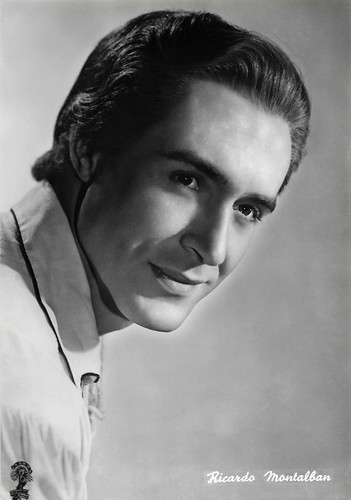
Italian postcard by Bromofoto, Milano, no. 1040. Photo: Columbia Pictures.
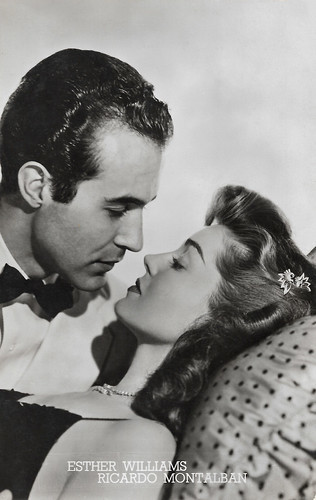
Belgian postcard, no. 951. Photo: Metro-Goldwyn-Mayer. Publicity still for Neptune's Daughter (Edward Buzzell, 1949) with Esther Williams.

Dutch postcard by Takken, Utrecht, no. 1694. Photo: Metro-Goldwyn-Mayer. Ricardo Montalban takes a few minutes between scenes of Two Weeks with Love (Roy Rowland, 1952) to start a summer tan.
He's a Latin from Staten Island
Ricardo Gonzalo Pedro Montalbán y Merino was born in Mexico City in 1920 and grew up in Torreón. He was the youngest of four children to Castilian Spanish immigrants, Ricarda Merino and Jenaro Montalbán, a dry goods store owner. Montalbán moved to Los Angeles as a teen and lived with his much older brother Carlos Montalbán, who was then pursuing show business as both an actor and dancer.
Ricardo attended Fairfax High School in Hollywood and was noticed in a student play but passed a screen test. In 1940, he travelled with his brother to New York, where he earned a bit part in the Tallulah Bankhead stage vehicle Her Cardboard Lover, and won subsequent roles in the plays Our Betters and Private Affair. In 1941, Montalbán appeared in three-minute musicals produced for the Soundies film jukeboxes. He appeared in many of them as an extra or as a member of a singing chorus, and had the lead role in He's a Latin from Staten Island (1941). Simply billed as 'Ricardo', he played the title role of a guitar-strumming gigolo, accompanied by an offscreen vocal by Gus Van.
Returning to Mexico to care for his ill mother, his dark good looks and magnetic style helped propel him into the Spanish-language film industry. After 13 Spanish-language films, he was on the verge of stardom in Mexico when MGM took an interest in him. Montalban relocated back to Los Angeles. The studio wanted to change his name to Ricky Martin, but he refused.
He made his Hollywood leading debut as a robust bullfighter and twin brother of Esther Williams in the musical Fiesta (Richard Thorpe, 1947), and attracted immediate attention. His second film with Williams, On an Island with You (Richard Thorpe, 1948), led to a contract with the studio. He routinely ignited 'Latin Lover' sparks opposite such female stars as Cyd Charisse, Shelley Winters, Anne Bancroft, Pier Angeli , Laraine Day and (once again) Esther Williams, this time in Neptune's Daughter (Edward Buzzell, 1949).
One of his MGM extravaganzas opposite gorgeous Lana Turner was actually called Latin Lovers (Mervyn LeRoy, 1953). In this musical comedy, he replaced his friendly Latin Lover rival Fernando Lamas, because Lana Turner's real-life affair with Lamas had just reached a tempestuous conclusion. During the 1950s and 1960s, Montalban was one of only a handful of actively working Hispanic actors in Hollywood. He was seldom able to extricate himself from the usual portrayals of gringos, bandidos and gigolos, although he sometimes portrayed other ethnicities – occasionally of Japanese background.
He managed to find roles in interesting films, such as his turn as a Mexican undercover cop in the gritty Border Incident (Anthony Mann, 1949), a Cape Cod police officer in Mystery Street (John Sturges, 1950), the classic war film Battleground (William A. Wellman, 1949) with Van Johnson, and the hard-edged boxing drama Right Cross (John Sturges, 1950) with June Allyson and Dick Powell. He played a villainous Blackfoot Indian chief in Across the Wide Missouri (William A. Wellman, 1951) starring Clark Gable, a heroic, bare-chested rebel warrior in the steamy Italian sword-and-sandals costumer La cortigiana di Babilonia/The Queen of Babylon (Carlo Ludovico Bragaglia, 1954) alongside Rhonda Fleming, and a Japanese Kabuki actor in the Oscar-winning feature Sayonara (Joshua Logan, 1957), starring Marlon Brando.
During the filming of Across the Wide Missouri (1951), he suffered a serious injury to his spine after he slipped and fell off a running horse, which resulted in a permanent limp. In 1954, Montalban returned to the stage with varied roles in such fare as Can-Can, The Inspector General, South Pacific and Accent on Youth. In 1955, he made his Broadway debut as Chico in the original musical Seventh Heaven with Gloria DeHaven. He then earned a Tony nomination as the only non-African-American actor in the tropical-themed musical Jamaica (1957) singing several light-hearted calypso numbers opposite Lena Horne. He also toured as the title role in Don Juan in Hell in the 1960s, returning to Broadway with it in 1973 with Agnes Moorehead, and touring once again with the show in 1991.

Belgian postcard. Photo: M.G.M. Jimmy Durante, Peter Lawford, Esther Williams, Cyd Charisse , Ricardo Montalban and Xavier Cugat in On an Island with You (Richard Thorpe, 1948).
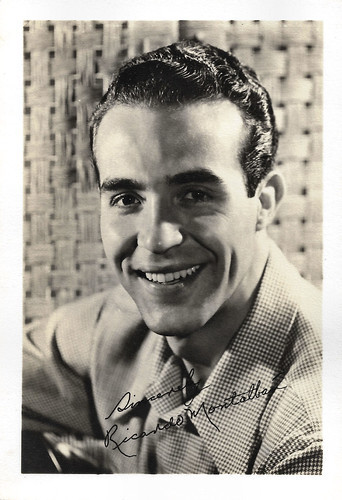
British autograph card.
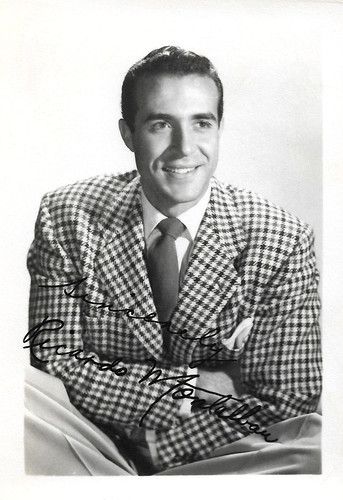
British autograph card.
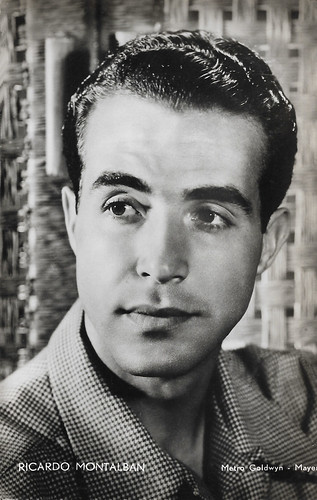
Belgian postcard, no. AX-131. Photo: Metro-Goldwyn-Mayer.
Typically Playing Continental Smoothies
Ricardo Montalban had a strong work ethic and a reservoir of talent which enabled him to continue on television long after his exotic beefcake status in films had waned. He had married Loretta Young's half-sister Georgiana Young in 1944, and appeared on his sister-in-law's television series The New Loretta Young Show (1962) several times. He also showed up in a number of television dramatic anthologies like Playhouse 90 (1956) and Colgate Theatre (1958), and made guest appearances on the popular series of the day, such as Bonanza (1959), Dr. Kildare (1961), Burke's Law (1963), and Hawaii Five-O (1968). Memorable was a 1967 Star Trek episode in which he portrayed galaxy arch-villain Khan Noonien Singh. He resurrected this character in the film Star Trek II: The Wrath of Khan (Nicholas Meyer, 1982), starring William Shatner and Leonard Nimoy.
Over the years, he continued to appear occasionally on the big screen, typically playing continental smoothies, in such films as Love Is a Ball (David Swift, 1963) starring Glenn Ford, Madame X (David Lowell Rich, 1966) featuring Lana Turner, and Sweet Charity (Bob Fosse, 1969) with Shirley MacLaine, but it was television that finally made him a household name.
Montalban won an Emmy for his role in the miniseries How the West Was Won (1976). He captivated audiences as the urbane, white-suited concierge of mystery Mr. Roarke in the Aaron Spelling series Fantasy Island (1977). He stayed with the series for six seasons, buoyed by his popular 'odd couple' teaming with Hervé Villechaize, who played Mr. Roarke's diminutive sidekick, and fellow greeter, Tattoo.
Gary Brumburgh at IMDb : "While it may have seemed a somewhat lightweight and undemanding role for the talented Montalban, it nevertheless became his signature character. The series faltered after Villechaize, who had become erratic and difficult on the set, was fired from the series in 1983. Corpulent Britisher Christopher Hewett, as Lawrence, replaced the Tattoo character but to little avail and the series was canceled one season later. The troubled Villechaize committed suicide in 1993."
Montalban was a noteworthy villain in the Dynasty (1981) spin-off soap series The Colbys (1985). Montalban was also famous for a series of television commercials in which he returned somewhat to his Latin lover persona. For years in the 1970s, he was a commercial spokesperson for Chrysler Corporation automobiles. Later, he good-naturedly spoofed his Hollywood image in a number of featured parts, including a hilarious send-up of himself in The Naked Gun: From the Files of Police Squad! (David Zucker, 1988), starring Leslie Nielsen. His deep, soothing, confident tones could also be heard in animated features and television series.
Frustrated at Hollywood's portrayal of Mexicans, he helped to found, and gave support to the image-building Nosotros organisation, a Los Angeles theatre-based company designed for Latinos working in the industry. In 1997, Nosotros and the Montalban foundation bought the historic Doolittle Theater in Hollywood, which was built in 1927, and renamed the theatre in his honour in 2004. It became the first major theatre facility (1200 seats) in the United States to carry the name of a Latino performing artist.
In 1980 he, along with Bob Thomas, published his memoir, 'Reflections: A Life in Two Worlds'. Gary Brumburgh: "A class act who was beloved in the industry for his gentle and caring nature, the long-term effects of his spinal injury eventually confined him to a wheelchair in his later years." In 1993, he had a 9 1/2 hour surgical operation on his spine to repair the old back injury. He had been in constant pain ever since. The operation left him paralysed below the waist and requiring the use of a wheelchair. That year, he won a Lifetime Achievement Award from the Screen Actors Guild.
Montalban continued to perform, providing voices for animated films and supporting his Nosotros foundation. Two of his final film roles were as the grandfather in the two Spy Kids sequels: Spy Kids 2: Island of Lost Dreams (Robert Rodriguez, 2002) and Spy Kids 3: Game Over (Robert Rodriguez, 2003). Rodriguez created the role specifically for Montalban, which included the use of a jet-propelled wheelchair.
Ricardo Montalban died in his Los Angeles home of complications from old age in 2009 at the age of 88. His wife, Georgiana Young, had died in 2007, and he was survived by their two daughters and two sons: Laura, Anita, Victor and Mark. Montalban was interred with his wife at Holy Cross Cemetery in Culver City, California.
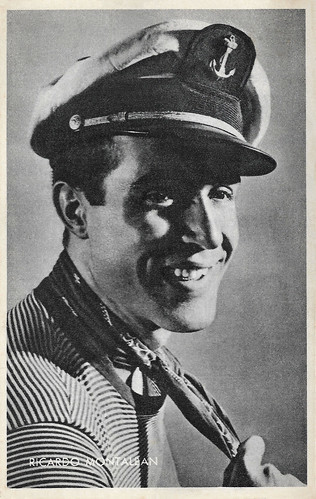
Belgian collectors card by Kwatta, Bois d'Haine, no. C. 149. Photo: Metro-Goldwyn-Mayer.
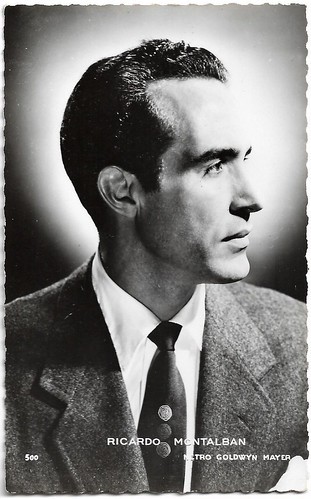
French postcard by Editions P.I., Paris, no. 500. Photo: Metro-Goldwyn-Mayer, 1953.
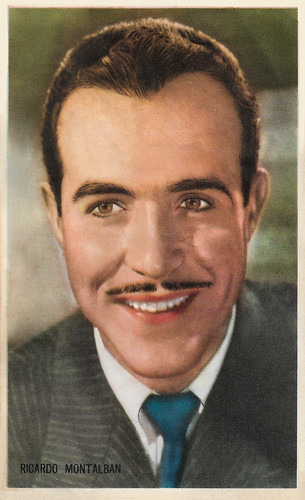
Belgian collectors card by Kwatta, Bois d'Haine, no. C. 317. Photo: Metro-Goldwyn-Mayer.
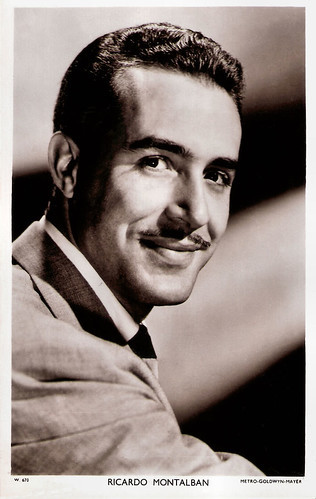
British postcard in the Picturegoer Series, London, no. W 670. Photo: Metro-Goldwyn-Mayer.
Sources: (IMDb), Wikipedia and .

Italian postcard by Bromofoto, Milano, no. 1040. Photo: Columbia Pictures.

Belgian postcard, no. 951. Photo: Metro-Goldwyn-Mayer. Publicity still for Neptune's Daughter (Edward Buzzell, 1949) with Esther Williams.

Dutch postcard by Takken, Utrecht, no. 1694. Photo: Metro-Goldwyn-Mayer. Ricardo Montalban takes a few minutes between scenes of Two Weeks with Love (Roy Rowland, 1952) to start a summer tan.
He's a Latin from Staten Island
Ricardo Gonzalo Pedro Montalbán y Merino was born in Mexico City in 1920 and grew up in Torreón. He was the youngest of four children to Castilian Spanish immigrants, Ricarda Merino and Jenaro Montalbán, a dry goods store owner. Montalbán moved to Los Angeles as a teen and lived with his much older brother Carlos Montalbán, who was then pursuing show business as both an actor and dancer.
Ricardo attended Fairfax High School in Hollywood and was noticed in a student play but passed a screen test. In 1940, he travelled with his brother to New York, where he earned a bit part in the Tallulah Bankhead stage vehicle Her Cardboard Lover, and won subsequent roles in the plays Our Betters and Private Affair. In 1941, Montalbán appeared in three-minute musicals produced for the Soundies film jukeboxes. He appeared in many of them as an extra or as a member of a singing chorus, and had the lead role in He's a Latin from Staten Island (1941). Simply billed as 'Ricardo', he played the title role of a guitar-strumming gigolo, accompanied by an offscreen vocal by Gus Van.
Returning to Mexico to care for his ill mother, his dark good looks and magnetic style helped propel him into the Spanish-language film industry. After 13 Spanish-language films, he was on the verge of stardom in Mexico when MGM took an interest in him. Montalban relocated back to Los Angeles. The studio wanted to change his name to Ricky Martin, but he refused.
He made his Hollywood leading debut as a robust bullfighter and twin brother of Esther Williams in the musical Fiesta (Richard Thorpe, 1947), and attracted immediate attention. His second film with Williams, On an Island with You (Richard Thorpe, 1948), led to a contract with the studio. He routinely ignited 'Latin Lover' sparks opposite such female stars as Cyd Charisse, Shelley Winters, Anne Bancroft, Pier Angeli , Laraine Day and (once again) Esther Williams, this time in Neptune's Daughter (Edward Buzzell, 1949).
One of his MGM extravaganzas opposite gorgeous Lana Turner was actually called Latin Lovers (Mervyn LeRoy, 1953). In this musical comedy, he replaced his friendly Latin Lover rival Fernando Lamas, because Lana Turner's real-life affair with Lamas had just reached a tempestuous conclusion. During the 1950s and 1960s, Montalban was one of only a handful of actively working Hispanic actors in Hollywood. He was seldom able to extricate himself from the usual portrayals of gringos, bandidos and gigolos, although he sometimes portrayed other ethnicities – occasionally of Japanese background.
He managed to find roles in interesting films, such as his turn as a Mexican undercover cop in the gritty Border Incident (Anthony Mann, 1949), a Cape Cod police officer in Mystery Street (John Sturges, 1950), the classic war film Battleground (William A. Wellman, 1949) with Van Johnson, and the hard-edged boxing drama Right Cross (John Sturges, 1950) with June Allyson and Dick Powell. He played a villainous Blackfoot Indian chief in Across the Wide Missouri (William A. Wellman, 1951) starring Clark Gable, a heroic, bare-chested rebel warrior in the steamy Italian sword-and-sandals costumer La cortigiana di Babilonia/The Queen of Babylon (Carlo Ludovico Bragaglia, 1954) alongside Rhonda Fleming, and a Japanese Kabuki actor in the Oscar-winning feature Sayonara (Joshua Logan, 1957), starring Marlon Brando.
During the filming of Across the Wide Missouri (1951), he suffered a serious injury to his spine after he slipped and fell off a running horse, which resulted in a permanent limp. In 1954, Montalban returned to the stage with varied roles in such fare as Can-Can, The Inspector General, South Pacific and Accent on Youth. In 1955, he made his Broadway debut as Chico in the original musical Seventh Heaven with Gloria DeHaven. He then earned a Tony nomination as the only non-African-American actor in the tropical-themed musical Jamaica (1957) singing several light-hearted calypso numbers opposite Lena Horne. He also toured as the title role in Don Juan in Hell in the 1960s, returning to Broadway with it in 1973 with Agnes Moorehead, and touring once again with the show in 1991.

Belgian postcard. Photo: M.G.M. Jimmy Durante, Peter Lawford, Esther Williams, Cyd Charisse , Ricardo Montalban and Xavier Cugat in On an Island with You (Richard Thorpe, 1948).

British autograph card.

British autograph card.

Belgian postcard, no. AX-131. Photo: Metro-Goldwyn-Mayer.
Typically Playing Continental Smoothies
Ricardo Montalban had a strong work ethic and a reservoir of talent which enabled him to continue on television long after his exotic beefcake status in films had waned. He had married Loretta Young's half-sister Georgiana Young in 1944, and appeared on his sister-in-law's television series The New Loretta Young Show (1962) several times. He also showed up in a number of television dramatic anthologies like Playhouse 90 (1956) and Colgate Theatre (1958), and made guest appearances on the popular series of the day, such as Bonanza (1959), Dr. Kildare (1961), Burke's Law (1963), and Hawaii Five-O (1968). Memorable was a 1967 Star Trek episode in which he portrayed galaxy arch-villain Khan Noonien Singh. He resurrected this character in the film Star Trek II: The Wrath of Khan (Nicholas Meyer, 1982), starring William Shatner and Leonard Nimoy.
Over the years, he continued to appear occasionally on the big screen, typically playing continental smoothies, in such films as Love Is a Ball (David Swift, 1963) starring Glenn Ford, Madame X (David Lowell Rich, 1966) featuring Lana Turner, and Sweet Charity (Bob Fosse, 1969) with Shirley MacLaine, but it was television that finally made him a household name.
Montalban won an Emmy for his role in the miniseries How the West Was Won (1976). He captivated audiences as the urbane, white-suited concierge of mystery Mr. Roarke in the Aaron Spelling series Fantasy Island (1977). He stayed with the series for six seasons, buoyed by his popular 'odd couple' teaming with Hervé Villechaize, who played Mr. Roarke's diminutive sidekick, and fellow greeter, Tattoo.
Gary Brumburgh at IMDb : "While it may have seemed a somewhat lightweight and undemanding role for the talented Montalban, it nevertheless became his signature character. The series faltered after Villechaize, who had become erratic and difficult on the set, was fired from the series in 1983. Corpulent Britisher Christopher Hewett, as Lawrence, replaced the Tattoo character but to little avail and the series was canceled one season later. The troubled Villechaize committed suicide in 1993."
Montalban was a noteworthy villain in the Dynasty (1981) spin-off soap series The Colbys (1985). Montalban was also famous for a series of television commercials in which he returned somewhat to his Latin lover persona. For years in the 1970s, he was a commercial spokesperson for Chrysler Corporation automobiles. Later, he good-naturedly spoofed his Hollywood image in a number of featured parts, including a hilarious send-up of himself in The Naked Gun: From the Files of Police Squad! (David Zucker, 1988), starring Leslie Nielsen. His deep, soothing, confident tones could also be heard in animated features and television series.
Frustrated at Hollywood's portrayal of Mexicans, he helped to found, and gave support to the image-building Nosotros organisation, a Los Angeles theatre-based company designed for Latinos working in the industry. In 1997, Nosotros and the Montalban foundation bought the historic Doolittle Theater in Hollywood, which was built in 1927, and renamed the theatre in his honour in 2004. It became the first major theatre facility (1200 seats) in the United States to carry the name of a Latino performing artist.
In 1980 he, along with Bob Thomas, published his memoir, 'Reflections: A Life in Two Worlds'. Gary Brumburgh: "A class act who was beloved in the industry for his gentle and caring nature, the long-term effects of his spinal injury eventually confined him to a wheelchair in his later years." In 1993, he had a 9 1/2 hour surgical operation on his spine to repair the old back injury. He had been in constant pain ever since. The operation left him paralysed below the waist and requiring the use of a wheelchair. That year, he won a Lifetime Achievement Award from the Screen Actors Guild.
Montalban continued to perform, providing voices for animated films and supporting his Nosotros foundation. Two of his final film roles were as the grandfather in the two Spy Kids sequels: Spy Kids 2: Island of Lost Dreams (Robert Rodriguez, 2002) and Spy Kids 3: Game Over (Robert Rodriguez, 2003). Rodriguez created the role specifically for Montalban, which included the use of a jet-propelled wheelchair.
Ricardo Montalban died in his Los Angeles home of complications from old age in 2009 at the age of 88. His wife, Georgiana Young, had died in 2007, and he was survived by their two daughters and two sons: Laura, Anita, Victor and Mark. Montalban was interred with his wife at Holy Cross Cemetery in Culver City, California.

Belgian collectors card by Kwatta, Bois d'Haine, no. C. 149. Photo: Metro-Goldwyn-Mayer.

French postcard by Editions P.I., Paris, no. 500. Photo: Metro-Goldwyn-Mayer, 1953.

Belgian collectors card by Kwatta, Bois d'Haine, no. C. 317. Photo: Metro-Goldwyn-Mayer.

British postcard in the Picturegoer Series, London, no. W 670. Photo: Metro-Goldwyn-Mayer.
Sources: (IMDb), Wikipedia and .
Published on June 30, 2019 22:00
June 29, 2019
Shirley Temple
Shirley Temple (1928-2014) was an American film and television actress, singer, dancer and public servant, but everybody knows her as the most famous child star in the 1930s. Shirley could do it all: act, sing and dance and all at the age of five! Four years in a row, between 1935 and 1938, she was the top box-office draw for Hollywood. As an adult, she entered politics and became a diplomat, serving as United States Ambassador to Ghana and later to Czechoslovakia, and as Chief of Protocol of the United States.
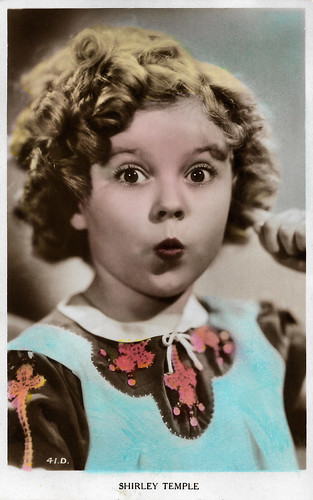
British Real Photograph postcard by Art Photo, no. 36.2. Photo: 20th Century Fox Film.
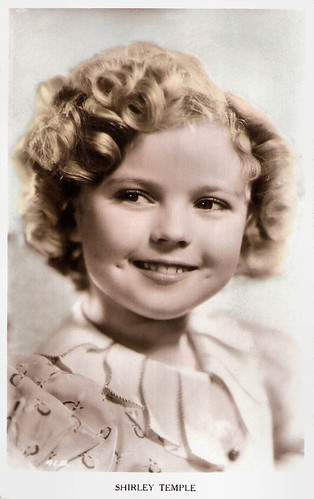
British Real Photograph postcard by Art Photo, no. 41B. Photo: 20th Century Fox Film.
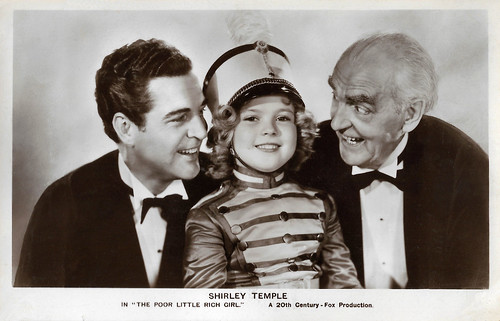
British Real Photograph postcard, London, no. FS 52. Photo: 20th Century Fox Film. Shirley Temple, Michael Whalen and Claude Gillingwater in Poor Little Rich Girl (Irving Cummings, 1936).
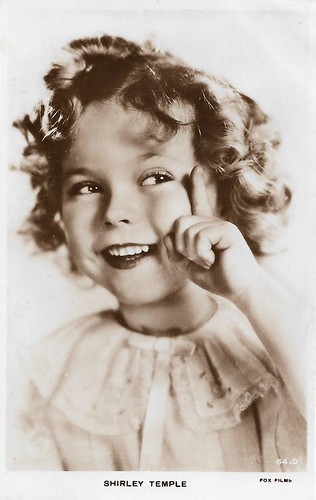
British Real Photograph postcard, no. 64 D. Photo: Fox Films.
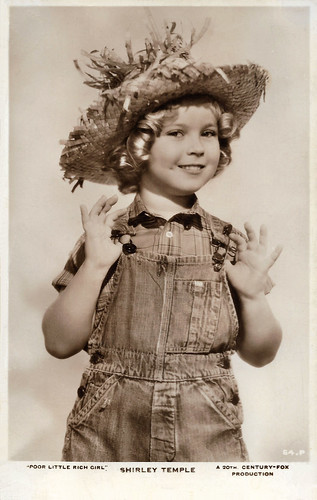
British Real Photograph postcard, London, no. 64.P. Photo: 20th Century Fox Film. Shirley Temple in Poor Little Rich Girl (Irving Cummings, 1936).
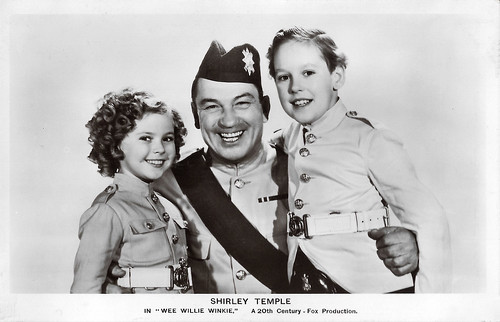
British Real Photograph postcard, London, no. FS 108. Photo: 20th Century Fox Film. Shirley Temple, Victor McLaglen and Douglas Scott in Wee Willie Winkie (John Ford, 1937).
Baby Burlesks
Shirley Temple was born in 1928, in Santa Monica, California. She was the third child of homemaker Gertrude Amelia Temple and bank employee George Francis Temple. The family was of Dutch, English, and German ancestry. She had two brothers: John Stanley, and George Francis, Jr. The family moved to Brentwood, Los Angeles.
Her mother encouraged her singing, dancing, and acting talents, and in September 1931 enrolled her in Meglin's Dance School in Los Angeles. At about this time, Shirley's mother began styling her daughter's hair in ringlets.
While at the dance school, she was spotted by Charles Lamont, who was a casting director for Educational Pictures. Temple hid behind the piano while she was in the studio. Lamont took a liking to Temple, and invited her to audition; he signed her to a contract in 1932.
At the age of three, Shirley Temple began her film career in Baby Burlesks (Charles Lamont, 1932), multiple short films satirising recent film and political events by using preschool children in every role.
A series of two-reelers called Frolics of Youth followed with Temple playing Mary Lou Rogers, a youngster in a contemporary suburban family. To underwrite production costs at Educational Pictures, she and her child co-stars modelled for breakfast cereals and other products.
She was lent to Tower Productions for a small role in her first feature film, The Red-Haired Alibi (Christy Cabanne, 1932) and, in 1933, to Universal, Paramount, and Warner Bros. Pictures for various parts. After Educational Pictures declared bankruptcy in 1933, her father managed to purchase her contract for just $25.
Fox Film songwriter Jay Gorney arranged for her to have a screen test for the film Stand Up and Cheer! (Hamilton MacFadden, 1934). She won the part and was signed to a $150-per-week contract that was guaranteed for two weeks by Fox Film Corporation. The role was her breakthrough. Temple's charm was evident to Fox executives, and she was ushered into corporate offices almost immediately after finishing 'Baby Take a Bow', a song-and-dance number she did with James Dunn.
Her contract was extended to a year at the same $150/week with a seven-year option and her mother Gertrude was hired on at $25/week as her hairdresser and personal coach. In June 1934, her success continued when she was loaned out to Paramount for Little Miss Marker (Alexander Hall, 1934) with Adolphe Menjou , a story about a little girl held as collateral by gangsters.
Then, she found international fame in Bright Eyes (David Butler, 1934) with James Dunn, a feature film designed specifically for her talents. Her signature song, 'On the Good Ship Lollipop', was introduced in the film. In 1935, she received a special Juvenile Academy Award for her performance.
In 1935, Fox Films merged with Twentieth Century Pictures to become 20th Century Fox. Producer and studio head Darryl F. Zanuck focused his attention and resources upon cultivating Shirley's superstar status. She was said to be the studio's greatest asset. Nineteen writers, known as the Shirley Temple Story Development team, made 11 original stories and some adaptations of the classics for her. Film hits such as Curly Top (Irving Cummings, 1935), Poor Little Rich Girl (Irving Cummings, 1936) and Heidi (Allan Dwan, 1937) followed year after year during the mid-to-late 1930s.
Most of the Shirley Temple films were inexpensively made at $200,000 or $300,000 apiece and were comedy-dramas with songs and dances added, sentimental and melodramatic situations, and bearing little production value. Her film titles are a clue to the way she was marketed—Curly Top (Irving Cummings, 1935) and Dimples (Wiliam A. Seiter, 1936), and her 'little' pictures such as The Little Colonel (David Butler, 1935) with Lionel Barrymore, and The Littlest Rebel (David Butler, 1935). Shirley often played a fixer-upper, a precocious Cupid, or the good fairy in these films, reuniting her estranged parents or smoothing out the wrinkles in the romances of young couples.

German postcard by Ross Verlag, no. 9793/4, 1935-1936. Photo: Fox.
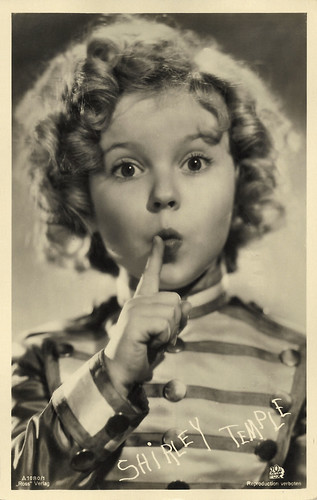
German postcard by Ross Verlag, no. A 1080/1, 1937-1938. Photo: 20th Century Fox Film. Shirley Temple in Poor Little Rich Girl (Irving Cummings, 1936).
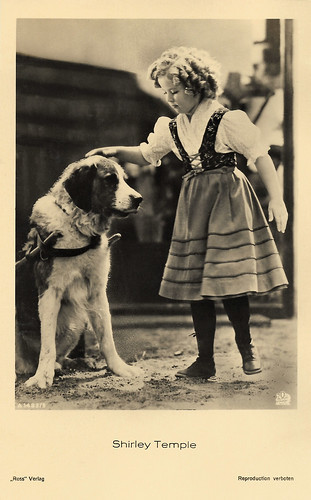
German postcard by Ross Verlag, no. A 1483/5, 1937-1938. Photo: 20th Century Fox Film. Shirley Temple in Heidi (Allan Dwan, 1937).
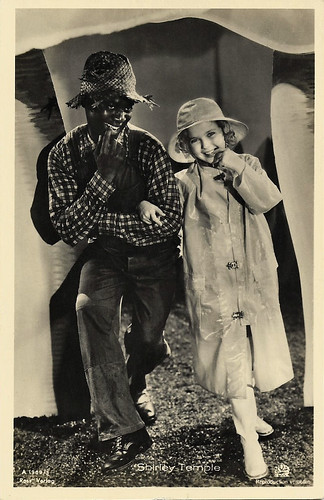
German postcard by Ross Verlag, no. A 1909/3, 1937-1938. Photo: 20th Century Fox. Shirley Temple and Bill Robinson in Just around the Corner (David Butler, 1938).
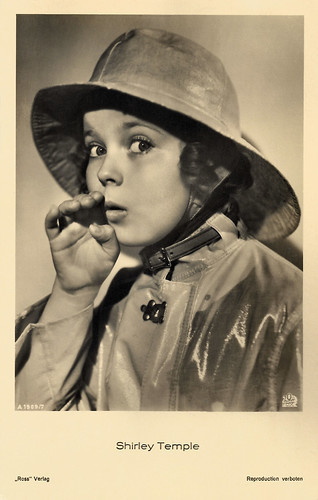
German postcard by Ross Verlag, no. A 1909/7, 1937-1938. Photo: 20th Century Fox. Shirley Temple in Captain January (David Butler, 1936).
Bright, bouncy and cheerful image
Based on Shirley Temple's many screen successes, Darryl F. Zanuck increased budgets and production values for her films. By the end of 1935, her salary was $2,500 a week. Licensed merchandise that capitalised on her bright, bouncy and cheerful image included dolls, dishes, and clothing.
In 1937, John Ford was hired to direct the sepia-toned Wee Willie Winkie (Temple's own favourite) and an A-list cast was signed that included Victor McLaglen , C. Aubrey Smith and Cesar Romero. Elaborate sets were built at the famed Iverson Movie Ranch in Chatsworth, for the production, with a rock feature at the heavily filmed location ranch eventually being named the Shirley Temple Rock. The film was a critical and commercial hit.
In 1938, Rebecca of Sunnybrook Farm (Allan Dwan, 1938) with Randolph Scott, Little Miss Broadway (Irving Cummings, 1938) and Just around the Corner (David Butler, 1938) were released. The latter two were panned by the critics, and Just Around the Corner was the first of her films to show a slump in ticket sales.
The following year, Zanuck secured the rights to the children's novel 'A Little Princess', believing the book would be an ideal vehicle for the girl. He budgeted the film at $1.5 million - twice the amount of Just around the Corner (David Butler, 1938) - and chose it to be her first Technicolor feature. The Little Princess (Walter Lang, William A. Seiter, 1939) was a critical and commercial success, with Shirley's acting at its peak. Zanuck then cast her in Susannah of the Mounties (William A. Seiter, Walter Lang, 1939), her last money-maker for Twentieth Century Fox.
Her box office popularity waned as she reached adolescence. Her parents bought up the remainder of her contract, and sent her, at the age of 12, to Westlake School for Girls, an exclusive country day school in Los Angeles.
In 1944, David O. Selznick signed Shirley Temple to a four-year contract. She appeared in two wartime hits: Since You Went Away (John Cromwell, Edward F. Cline, 1944), and I'll Be Seeing You (William Dieterle, 1944). Selznick, however, became romantically involved with Jennifer Jones, and lost interest in developing Shirley's career. Temple was then lent to other studios. Kiss and Tell (Richard Wallace, 1945), The Bachelor and the Bobby-Soxer (Irving Reis, 1947) with Cary Grant, and Fort Apache (John Ford, 1948) with John Wayne and Henry Fonda, were her few good films at the time. Temple left the film industry in 1950 at the age of 22.
In 1958, Temple returned to show business with a two-season television anthology series of fairy tale adaptations, Shirley Temple's Storybook. She made guest appearances on television shows in the early 1960s and filmed a sitcom pilot that was never released. She sat on the boards of corporations and organisations including The Walt Disney Company, Del Monte Foods, and the National Wildlife Federation.
She began her diplomatic career in 1969, when she was appointed to represent the United States at a session of the United Nations General Assembly, where she worked at the U.S Mission under Ambassador Charles W. Yost. In 1988, she published her autobiography, 'Child Star'.
In 1943, 15-year-old Temple met John Agar, an Army Air Corps sergeant, physical training instructor, and member of a Chicago meat-packing family. She married him in 1945 before 500 guests. In 1948, Temple bore a daughter, Linda Susan. Agar became an actor, and the couple made two films together: Fort Apache (John Ford, 1948) and Adventure in Baltimore (1949). The marriage became troubled, and Temple divorced Agar on December in 1950. She was awarded custody of their daughter.
In January 1950, Temple met Charles Alden Black, a World War II Navy intelligence officer and Silver Star recipient and reputedly one of the richest young men in California. Temple and Black were married in his parents' Del Monte, California home in 1950. In 1952, Temple gave birth to a son, Charles Alden Black, Jr., and in 1954 to a daughter, Lori. The couple were married for 54 years until his death in 2005.
Shirley Temple Black was 85, when she died in 2014 in Woodside, California. Temple was the recipient of numerous awards and honours, including the Kennedy Center Honors and a Screen Actors Guild Life Achievement Award.
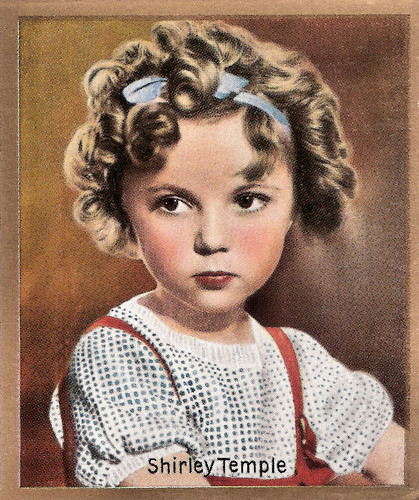
German collectors card in the Unsere Bunten Filmbilder series by Cigarettenfabrik Josetti, Berlin, no. 229. Photo: Fox / Ross Verlag.
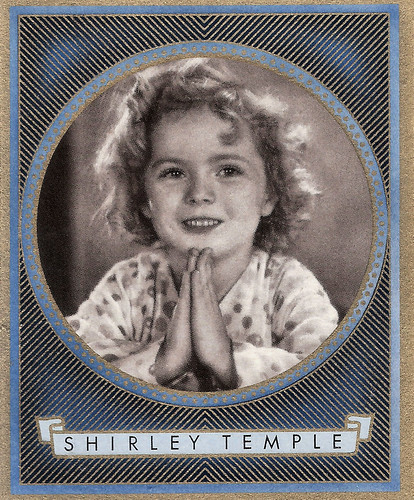
German collectors card in the Bunte Filmbilder series by Caid, Series no. 2, no. 496. Photo: Fox-Film / Ross Verlag.
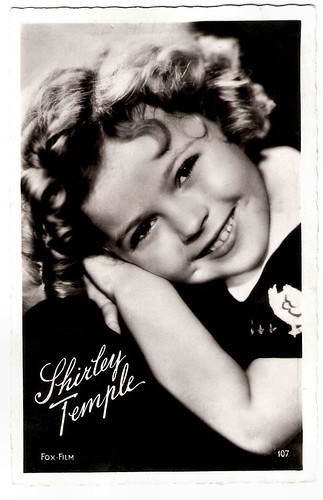
French postcard by Editions et Publications Cinématographiques, no. 107. Photo: Fox-Film.
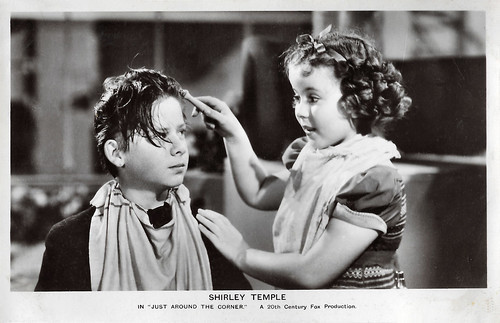
British Real Photograph postcard, London, no. FS 181. Photo: 20th Century Fox. Shirley Temple and Bennie Bartlett in Just Around the Corner (Irving Cummings, 1938).
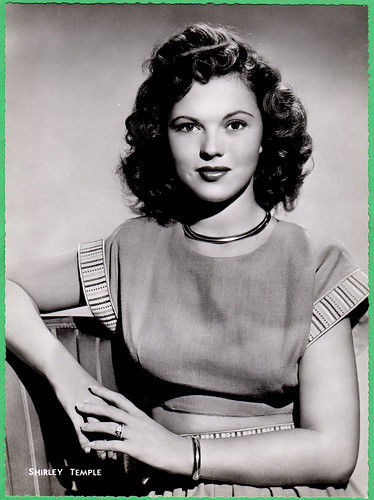
Belgian collectors card by Chocolaterie Clovis, Pepinster. Collection: Amit Benyovits.
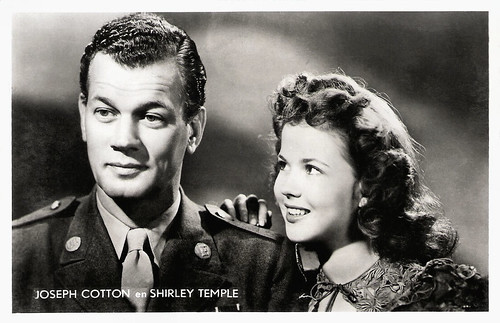
Dutch postcard by J. Sleding N.V., Amsterdam, no. 31 HL. Photo: Nederland Film. Joseph Cotten and Shirley Temple in I'll Be Seeing You (William Dieterle, 1944).
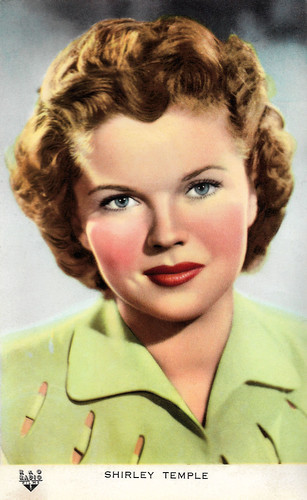
Belgian postcard by N.V. Victoria, Brussels, no. 639 / 27. Photo: RKO Radio Films.
Sources: Wikipedia and .

British Real Photograph postcard by Art Photo, no. 36.2. Photo: 20th Century Fox Film.

British Real Photograph postcard by Art Photo, no. 41B. Photo: 20th Century Fox Film.

British Real Photograph postcard, London, no. FS 52. Photo: 20th Century Fox Film. Shirley Temple, Michael Whalen and Claude Gillingwater in Poor Little Rich Girl (Irving Cummings, 1936).

British Real Photograph postcard, no. 64 D. Photo: Fox Films.

British Real Photograph postcard, London, no. 64.P. Photo: 20th Century Fox Film. Shirley Temple in Poor Little Rich Girl (Irving Cummings, 1936).

British Real Photograph postcard, London, no. FS 108. Photo: 20th Century Fox Film. Shirley Temple, Victor McLaglen and Douglas Scott in Wee Willie Winkie (John Ford, 1937).
Baby Burlesks
Shirley Temple was born in 1928, in Santa Monica, California. She was the third child of homemaker Gertrude Amelia Temple and bank employee George Francis Temple. The family was of Dutch, English, and German ancestry. She had two brothers: John Stanley, and George Francis, Jr. The family moved to Brentwood, Los Angeles.
Her mother encouraged her singing, dancing, and acting talents, and in September 1931 enrolled her in Meglin's Dance School in Los Angeles. At about this time, Shirley's mother began styling her daughter's hair in ringlets.
While at the dance school, she was spotted by Charles Lamont, who was a casting director for Educational Pictures. Temple hid behind the piano while she was in the studio. Lamont took a liking to Temple, and invited her to audition; he signed her to a contract in 1932.
At the age of three, Shirley Temple began her film career in Baby Burlesks (Charles Lamont, 1932), multiple short films satirising recent film and political events by using preschool children in every role.
A series of two-reelers called Frolics of Youth followed with Temple playing Mary Lou Rogers, a youngster in a contemporary suburban family. To underwrite production costs at Educational Pictures, she and her child co-stars modelled for breakfast cereals and other products.
She was lent to Tower Productions for a small role in her first feature film, The Red-Haired Alibi (Christy Cabanne, 1932) and, in 1933, to Universal, Paramount, and Warner Bros. Pictures for various parts. After Educational Pictures declared bankruptcy in 1933, her father managed to purchase her contract for just $25.
Fox Film songwriter Jay Gorney arranged for her to have a screen test for the film Stand Up and Cheer! (Hamilton MacFadden, 1934). She won the part and was signed to a $150-per-week contract that was guaranteed for two weeks by Fox Film Corporation. The role was her breakthrough. Temple's charm was evident to Fox executives, and she was ushered into corporate offices almost immediately after finishing 'Baby Take a Bow', a song-and-dance number she did with James Dunn.
Her contract was extended to a year at the same $150/week with a seven-year option and her mother Gertrude was hired on at $25/week as her hairdresser and personal coach. In June 1934, her success continued when she was loaned out to Paramount for Little Miss Marker (Alexander Hall, 1934) with Adolphe Menjou , a story about a little girl held as collateral by gangsters.
Then, she found international fame in Bright Eyes (David Butler, 1934) with James Dunn, a feature film designed specifically for her talents. Her signature song, 'On the Good Ship Lollipop', was introduced in the film. In 1935, she received a special Juvenile Academy Award for her performance.
In 1935, Fox Films merged with Twentieth Century Pictures to become 20th Century Fox. Producer and studio head Darryl F. Zanuck focused his attention and resources upon cultivating Shirley's superstar status. She was said to be the studio's greatest asset. Nineteen writers, known as the Shirley Temple Story Development team, made 11 original stories and some adaptations of the classics for her. Film hits such as Curly Top (Irving Cummings, 1935), Poor Little Rich Girl (Irving Cummings, 1936) and Heidi (Allan Dwan, 1937) followed year after year during the mid-to-late 1930s.
Most of the Shirley Temple films were inexpensively made at $200,000 or $300,000 apiece and were comedy-dramas with songs and dances added, sentimental and melodramatic situations, and bearing little production value. Her film titles are a clue to the way she was marketed—Curly Top (Irving Cummings, 1935) and Dimples (Wiliam A. Seiter, 1936), and her 'little' pictures such as The Little Colonel (David Butler, 1935) with Lionel Barrymore, and The Littlest Rebel (David Butler, 1935). Shirley often played a fixer-upper, a precocious Cupid, or the good fairy in these films, reuniting her estranged parents or smoothing out the wrinkles in the romances of young couples.

German postcard by Ross Verlag, no. 9793/4, 1935-1936. Photo: Fox.

German postcard by Ross Verlag, no. A 1080/1, 1937-1938. Photo: 20th Century Fox Film. Shirley Temple in Poor Little Rich Girl (Irving Cummings, 1936).

German postcard by Ross Verlag, no. A 1483/5, 1937-1938. Photo: 20th Century Fox Film. Shirley Temple in Heidi (Allan Dwan, 1937).

German postcard by Ross Verlag, no. A 1909/3, 1937-1938. Photo: 20th Century Fox. Shirley Temple and Bill Robinson in Just around the Corner (David Butler, 1938).

German postcard by Ross Verlag, no. A 1909/7, 1937-1938. Photo: 20th Century Fox. Shirley Temple in Captain January (David Butler, 1936).
Bright, bouncy and cheerful image
Based on Shirley Temple's many screen successes, Darryl F. Zanuck increased budgets and production values for her films. By the end of 1935, her salary was $2,500 a week. Licensed merchandise that capitalised on her bright, bouncy and cheerful image included dolls, dishes, and clothing.
In 1937, John Ford was hired to direct the sepia-toned Wee Willie Winkie (Temple's own favourite) and an A-list cast was signed that included Victor McLaglen , C. Aubrey Smith and Cesar Romero. Elaborate sets were built at the famed Iverson Movie Ranch in Chatsworth, for the production, with a rock feature at the heavily filmed location ranch eventually being named the Shirley Temple Rock. The film was a critical and commercial hit.
In 1938, Rebecca of Sunnybrook Farm (Allan Dwan, 1938) with Randolph Scott, Little Miss Broadway (Irving Cummings, 1938) and Just around the Corner (David Butler, 1938) were released. The latter two were panned by the critics, and Just Around the Corner was the first of her films to show a slump in ticket sales.
The following year, Zanuck secured the rights to the children's novel 'A Little Princess', believing the book would be an ideal vehicle for the girl. He budgeted the film at $1.5 million - twice the amount of Just around the Corner (David Butler, 1938) - and chose it to be her first Technicolor feature. The Little Princess (Walter Lang, William A. Seiter, 1939) was a critical and commercial success, with Shirley's acting at its peak. Zanuck then cast her in Susannah of the Mounties (William A. Seiter, Walter Lang, 1939), her last money-maker for Twentieth Century Fox.
Her box office popularity waned as she reached adolescence. Her parents bought up the remainder of her contract, and sent her, at the age of 12, to Westlake School for Girls, an exclusive country day school in Los Angeles.
In 1944, David O. Selznick signed Shirley Temple to a four-year contract. She appeared in two wartime hits: Since You Went Away (John Cromwell, Edward F. Cline, 1944), and I'll Be Seeing You (William Dieterle, 1944). Selznick, however, became romantically involved with Jennifer Jones, and lost interest in developing Shirley's career. Temple was then lent to other studios. Kiss and Tell (Richard Wallace, 1945), The Bachelor and the Bobby-Soxer (Irving Reis, 1947) with Cary Grant, and Fort Apache (John Ford, 1948) with John Wayne and Henry Fonda, were her few good films at the time. Temple left the film industry in 1950 at the age of 22.
In 1958, Temple returned to show business with a two-season television anthology series of fairy tale adaptations, Shirley Temple's Storybook. She made guest appearances on television shows in the early 1960s and filmed a sitcom pilot that was never released. She sat on the boards of corporations and organisations including The Walt Disney Company, Del Monte Foods, and the National Wildlife Federation.
She began her diplomatic career in 1969, when she was appointed to represent the United States at a session of the United Nations General Assembly, where she worked at the U.S Mission under Ambassador Charles W. Yost. In 1988, she published her autobiography, 'Child Star'.
In 1943, 15-year-old Temple met John Agar, an Army Air Corps sergeant, physical training instructor, and member of a Chicago meat-packing family. She married him in 1945 before 500 guests. In 1948, Temple bore a daughter, Linda Susan. Agar became an actor, and the couple made two films together: Fort Apache (John Ford, 1948) and Adventure in Baltimore (1949). The marriage became troubled, and Temple divorced Agar on December in 1950. She was awarded custody of their daughter.
In January 1950, Temple met Charles Alden Black, a World War II Navy intelligence officer and Silver Star recipient and reputedly one of the richest young men in California. Temple and Black were married in his parents' Del Monte, California home in 1950. In 1952, Temple gave birth to a son, Charles Alden Black, Jr., and in 1954 to a daughter, Lori. The couple were married for 54 years until his death in 2005.
Shirley Temple Black was 85, when she died in 2014 in Woodside, California. Temple was the recipient of numerous awards and honours, including the Kennedy Center Honors and a Screen Actors Guild Life Achievement Award.

German collectors card in the Unsere Bunten Filmbilder series by Cigarettenfabrik Josetti, Berlin, no. 229. Photo: Fox / Ross Verlag.

German collectors card in the Bunte Filmbilder series by Caid, Series no. 2, no. 496. Photo: Fox-Film / Ross Verlag.

French postcard by Editions et Publications Cinématographiques, no. 107. Photo: Fox-Film.

British Real Photograph postcard, London, no. FS 181. Photo: 20th Century Fox. Shirley Temple and Bennie Bartlett in Just Around the Corner (Irving Cummings, 1938).

Belgian collectors card by Chocolaterie Clovis, Pepinster. Collection: Amit Benyovits.

Dutch postcard by J. Sleding N.V., Amsterdam, no. 31 HL. Photo: Nederland Film. Joseph Cotten and Shirley Temple in I'll Be Seeing You (William Dieterle, 1944).

Belgian postcard by N.V. Victoria, Brussels, no. 639 / 27. Photo: RKO Radio Films.
Sources: Wikipedia and .
Published on June 29, 2019 22:00
June 28, 2019
Rendez-nous Musidora!
Cinema Ritrovato presented this week Rendez-nous Musidora!, a rich programme focusing on the French mega-star. With her heavily kohled dark eyes, somewhat sinister make-up, pale skin and exotic wardrobes, Musidora (1889-1957) created an unforgettable vamp persona. Musidora is best known for her roles in the Louis Feuillade serials Les Vampires (1915-1916) as Irma Vep (an anagram for ‘vampire’), the voluptuous leader of a gang of criminals, and in Judex (1917) as Marie Verdier. At a time when many women in the film industry were relegated to acting, Musidora also achieved some success as a producer and director. Later she became a journalist and wrote about cinema. This is our final Cinema Ritrovato 2019 post. Arrivederci!
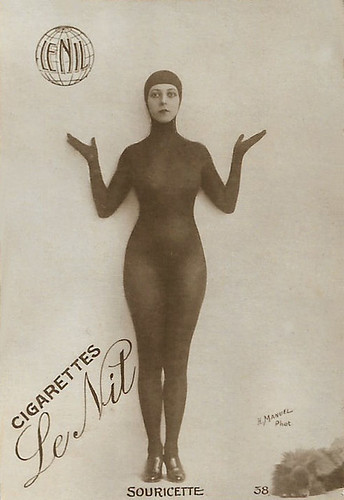
French cigarette card by Cigarettes Le Nil, no. 38. Photo: H. Manuel.
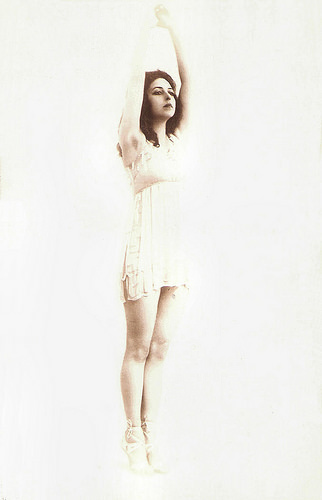
French postcard by Editions Gordon & Cie., Vincennes (Seine).
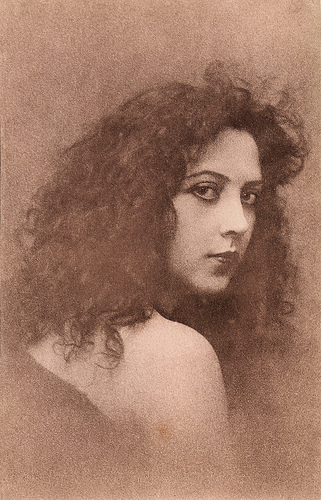
French postcard by Editions Sid, Paris, no. 8039. Photo: G.I. Manuel Frères.
Gift of the Muses
Musidora was born Jeanne Roques in Paris, France in 1889. She was raised by a feminist mother and socialist father.
She began her career in the arts at an early age, writing her first novel at the age of fifteen and acting on the stage with the likes of Colette, one of her lifelong friends. She performed in revues at French music halls and cabarets, such as the Folies Bergère, Concert Mayol, and La Cigale. Jeanne adopted the stage name Musidora (Greek for 'gift of the muses'), after the heroine in Théophile Gautier's novel Fortunio.
She made her film debut already around 1909, but in 1914, she started to appear regularly in short silent films like Les miseres de l'aiguille/The misery of the needle (Raphael Clamour, 1914). She starred in a few silent films by Gaston Ravel, including La bouquetière des Catalans/The Flower Girl of Catalonia (Gaston Ravel, 1914) and Le trophée du Zouave/The Zouave trophy (Gaston Ravel, 1915).
She also began to work with the highly successful film director Louis Feuillade, and appeared in a dozen of his short silent films for Gaumont. These included Severo Torelli (Louis Feuillade, 1914), Tu n'épouseras jamais un avocet/You will never marry a lawyer (Louis Feuillade, 1914) featuring Marcel Lévesque , Le calvaire/The Calvary (Louis Feuillade, 1914) with René Navarre , and Les noces d'argent/Silver Wedding (Louis Feuillade, 1915) with Édouard Mathé .
Musidora then appeared in his hugely successful serial Les Vampires/The Vampires (Louis Feuillade, 1915-1916) as cabaret singer Irma Vep opposite Édouard Mathé as crusading journalist Philippe Guerande.
Musidora’s mystique was accentuated in Les Vampires by her large, dark eyes and wearing a black leotard, hood and tights. Les Vampires was not actually about vampires, but about a criminal gang-cum-secret society inspired by the exploits of the real-life Bonnot Gang.
Irma Vep was adored by the surrealists, who deemed her both an embodiment of cinema itself and the projection of the deepest truth of the time. A modern fairy, a haunting enigma made flesh, night incarnate in her black silk catsuit, a bewitching shadow, the elusive and wild character of Irma Vep, with her dark-eyed gaze and seductive silhouette, made the actress Musidora immortal.
Besides playing a leading role in the Vampires' crimes, Irma Vep also spends two episodes under the hypnotic control of Moreno, a rival criminal who makes her his lover and induces her to assassinate the Grand Vampire. The series used gadgets like poison rings, poison fountain pens, cabinets with fake back panels etc. It was an immediate success with French cinema-goers and ran in 10 installments until 1916.
After the Les Vampires serial, Musidora starred in Judex (Louis Feuillade, 1917), another popular Feuillade serial filmed in 1916 but delayed for release until 1917 because of World War I. Judex is a twelve part serial following the adventures of the masked vigilante Judex ( René Cresté ) as he fights against criminals led by the corrupt banker Favrauxom. Les Vampires and Judex have been lauded by critics like André Bazin as the birth of avant-garde cinema and cited by filmmakers as Fritz Lang and Luis Buñuel as being extremely influential in their desires to become directors.
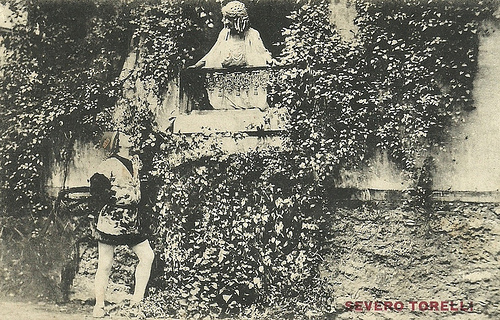
French postcard by Maury's International Attraction Circuit. Photo: publicity still for Severo Torelli (Louis Feuillade, 1914). Severo Torelli was a French silent feature, produced by Gaumont and based on a 1883 play by François Coppée. Fernand Herrmann played the title role and the female lead was for Renée Carl (Dona Pia). Musidora played Portia.
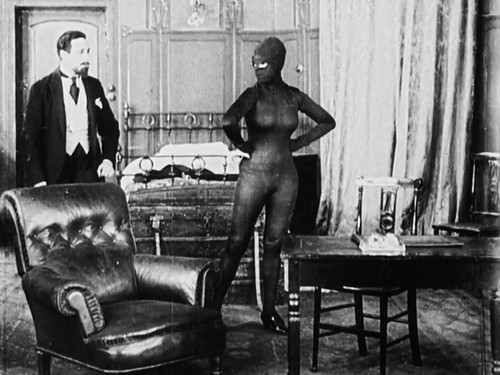
Musidora as Irma Vep in Les Vampires (Louis Feuillade, 1915-1916). Collection: The Island of Cinema @ Flickr.
The most deserving girl of France
Musidora also starred in films by other directors, like in Le pied qui étreint (Jacques Feyder, 1916) - a funny send-up of the Feuillade's serials, the silent adventure film Les chacals/The Jackals (André Hugon, 1917), starring André Nox , La jeune fille la plus méritante de France/The most deserving girl of France (Germaine Dulac, 1918), and Mademoiselle Chiffon (André Hugon, 1919), with Suzanne Munte.
Apart from her acting career, she became a film producer and director under the tutelage of her mentor, Louis Feuillade. Her first film was an adaptation of a novel by her friend Colette, La vagabonda/The Vagabond (Musidora, Eugenio Perego, 1918). Between the late 1910s and early 1920s, she directed ten films, all of which are lost with the exception of two: the tragic romance Soleil et ombre/Sol y sombre/Sun and Shadow (Jaime De Lasuen, Musidora, 1922) and La terre des taureaux/La tierra de los toros/The Land of the Bulls (Musidora, 1924), both of which were filmed in Spain, starring the Cordoban mounted bullfighter Antonio Cañero.
In Italy, she produced and directed La Flamme Cachée/The Hidden Flame (Roger Lion, Musidora, 1918) based on another work by Colette. At a time when many women in the film industry were relegated to acting, Musidora achieved a degree of success as a producer and director.
Annette Förster writes in an article at Women Film Pioneers Project: “While her films were favorably reviewed in the press, Musidora as producer reputedly only lost money on them. It remains unclear whether this was due to the terms of her contract, as she claimed in a 1946 interview with Renee Sylvaire , or to the fact that the films failed at the box office.”
Her final film role was as Delilah in the drama Le berceau de dieu/The Cradle of God (Fred LeRoy Granville, 1926) After her career as an actress was over, she focused on writing and producing. Her last film was an homage to her mentor Feuillade entitled La Magique Image/The Magic Image (1950), which she both directed and starred in.
Late in her life she would occasionally work in the ticket booth of the Cinematheque Francaise. Few patrons realised that the older woman in the foyer might be starring in the film they were watching.
At 68, Musidora died in Paris, France in 1957 and was laid to rest in the Cimetière de Bois-le-Roi. Musidora was married to Dr. Clément Marot from 1927 till 1944. The union produced one child, Clément Marot Jr.
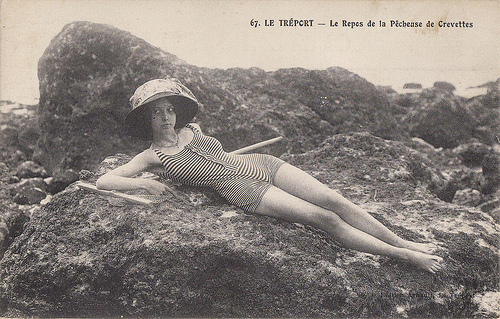
French postcard, no. 67. Caption: Le Tréport - Le Repos de la Pêcheuse de Crevettes. (Le Tréport - The Rest of the Shrimp Fisherwoman). Collection: Marlène Pilaete.
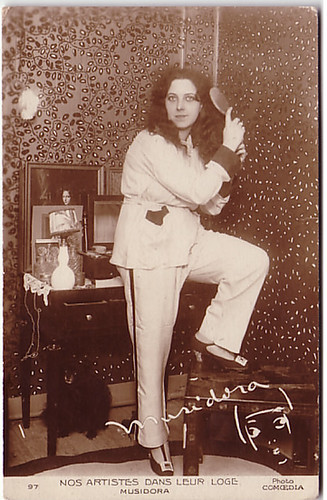
French postcard in the Nos Artistes dans leur loge series. Photo: Comoedia. Collection: Beth Ann Gallagher (Flickr).
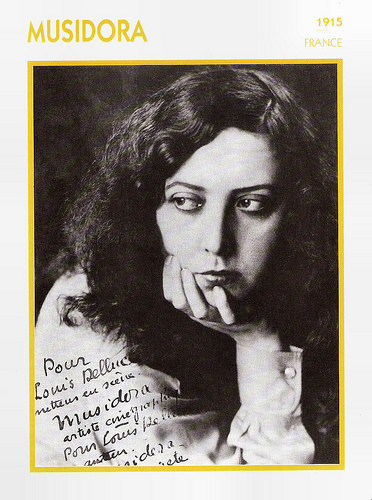
French collectors card in the series 'Portrait de Stars; L'encyclopédie du Cinéma' by Edito Service, 1992. Photo: Collection Cinémathèque Française. Caption: Musidora, 1915, France.
Sources: Annette Förster (Women Film Pioneers Project), Bobb Edwards (Find A Grave), Wikipedia, and .

French cigarette card by Cigarettes Le Nil, no. 38. Photo: H. Manuel.

French postcard by Editions Gordon & Cie., Vincennes (Seine).

French postcard by Editions Sid, Paris, no. 8039. Photo: G.I. Manuel Frères.
Gift of the Muses
Musidora was born Jeanne Roques in Paris, France in 1889. She was raised by a feminist mother and socialist father.
She began her career in the arts at an early age, writing her first novel at the age of fifteen and acting on the stage with the likes of Colette, one of her lifelong friends. She performed in revues at French music halls and cabarets, such as the Folies Bergère, Concert Mayol, and La Cigale. Jeanne adopted the stage name Musidora (Greek for 'gift of the muses'), after the heroine in Théophile Gautier's novel Fortunio.
She made her film debut already around 1909, but in 1914, she started to appear regularly in short silent films like Les miseres de l'aiguille/The misery of the needle (Raphael Clamour, 1914). She starred in a few silent films by Gaston Ravel, including La bouquetière des Catalans/The Flower Girl of Catalonia (Gaston Ravel, 1914) and Le trophée du Zouave/The Zouave trophy (Gaston Ravel, 1915).
She also began to work with the highly successful film director Louis Feuillade, and appeared in a dozen of his short silent films for Gaumont. These included Severo Torelli (Louis Feuillade, 1914), Tu n'épouseras jamais un avocet/You will never marry a lawyer (Louis Feuillade, 1914) featuring Marcel Lévesque , Le calvaire/The Calvary (Louis Feuillade, 1914) with René Navarre , and Les noces d'argent/Silver Wedding (Louis Feuillade, 1915) with Édouard Mathé .
Musidora then appeared in his hugely successful serial Les Vampires/The Vampires (Louis Feuillade, 1915-1916) as cabaret singer Irma Vep opposite Édouard Mathé as crusading journalist Philippe Guerande.
Musidora’s mystique was accentuated in Les Vampires by her large, dark eyes and wearing a black leotard, hood and tights. Les Vampires was not actually about vampires, but about a criminal gang-cum-secret society inspired by the exploits of the real-life Bonnot Gang.
Irma Vep was adored by the surrealists, who deemed her both an embodiment of cinema itself and the projection of the deepest truth of the time. A modern fairy, a haunting enigma made flesh, night incarnate in her black silk catsuit, a bewitching shadow, the elusive and wild character of Irma Vep, with her dark-eyed gaze and seductive silhouette, made the actress Musidora immortal.
Besides playing a leading role in the Vampires' crimes, Irma Vep also spends two episodes under the hypnotic control of Moreno, a rival criminal who makes her his lover and induces her to assassinate the Grand Vampire. The series used gadgets like poison rings, poison fountain pens, cabinets with fake back panels etc. It was an immediate success with French cinema-goers and ran in 10 installments until 1916.
After the Les Vampires serial, Musidora starred in Judex (Louis Feuillade, 1917), another popular Feuillade serial filmed in 1916 but delayed for release until 1917 because of World War I. Judex is a twelve part serial following the adventures of the masked vigilante Judex ( René Cresté ) as he fights against criminals led by the corrupt banker Favrauxom. Les Vampires and Judex have been lauded by critics like André Bazin as the birth of avant-garde cinema and cited by filmmakers as Fritz Lang and Luis Buñuel as being extremely influential in their desires to become directors.

French postcard by Maury's International Attraction Circuit. Photo: publicity still for Severo Torelli (Louis Feuillade, 1914). Severo Torelli was a French silent feature, produced by Gaumont and based on a 1883 play by François Coppée. Fernand Herrmann played the title role and the female lead was for Renée Carl (Dona Pia). Musidora played Portia.

Musidora as Irma Vep in Les Vampires (Louis Feuillade, 1915-1916). Collection: The Island of Cinema @ Flickr.
The most deserving girl of France
Musidora also starred in films by other directors, like in Le pied qui étreint (Jacques Feyder, 1916) - a funny send-up of the Feuillade's serials, the silent adventure film Les chacals/The Jackals (André Hugon, 1917), starring André Nox , La jeune fille la plus méritante de France/The most deserving girl of France (Germaine Dulac, 1918), and Mademoiselle Chiffon (André Hugon, 1919), with Suzanne Munte.
Apart from her acting career, she became a film producer and director under the tutelage of her mentor, Louis Feuillade. Her first film was an adaptation of a novel by her friend Colette, La vagabonda/The Vagabond (Musidora, Eugenio Perego, 1918). Between the late 1910s and early 1920s, she directed ten films, all of which are lost with the exception of two: the tragic romance Soleil et ombre/Sol y sombre/Sun and Shadow (Jaime De Lasuen, Musidora, 1922) and La terre des taureaux/La tierra de los toros/The Land of the Bulls (Musidora, 1924), both of which were filmed in Spain, starring the Cordoban mounted bullfighter Antonio Cañero.
In Italy, she produced and directed La Flamme Cachée/The Hidden Flame (Roger Lion, Musidora, 1918) based on another work by Colette. At a time when many women in the film industry were relegated to acting, Musidora achieved a degree of success as a producer and director.
Annette Förster writes in an article at Women Film Pioneers Project: “While her films were favorably reviewed in the press, Musidora as producer reputedly only lost money on them. It remains unclear whether this was due to the terms of her contract, as she claimed in a 1946 interview with Renee Sylvaire , or to the fact that the films failed at the box office.”
Her final film role was as Delilah in the drama Le berceau de dieu/The Cradle of God (Fred LeRoy Granville, 1926) After her career as an actress was over, she focused on writing and producing. Her last film was an homage to her mentor Feuillade entitled La Magique Image/The Magic Image (1950), which she both directed and starred in.
Late in her life she would occasionally work in the ticket booth of the Cinematheque Francaise. Few patrons realised that the older woman in the foyer might be starring in the film they were watching.
At 68, Musidora died in Paris, France in 1957 and was laid to rest in the Cimetière de Bois-le-Roi. Musidora was married to Dr. Clément Marot from 1927 till 1944. The union produced one child, Clément Marot Jr.

French postcard, no. 67. Caption: Le Tréport - Le Repos de la Pêcheuse de Crevettes. (Le Tréport - The Rest of the Shrimp Fisherwoman). Collection: Marlène Pilaete.

French postcard in the Nos Artistes dans leur loge series. Photo: Comoedia. Collection: Beth Ann Gallagher (Flickr).

French collectors card in the series 'Portrait de Stars; L'encyclopédie du Cinéma' by Edito Service, 1992. Photo: Collection Cinémathèque Française. Caption: Musidora, 1915, France.
Sources: Annette Förster (Women Film Pioneers Project), Bobb Edwards (Find A Grave), Wikipedia, and .
Published on June 28, 2019 22:00
June 27, 2019
A Neapolitan at Cinecittà, Eduardo De Filippo the Filmmaker
We're in Bologna, Italy, and like every year, EFSP follows Cinema Ritrovato! This festival we like to discover the genius of Neapolitan actor-director Eduardo De Filippo (1900-1985) as filmmaker in Cinecittà. This towering, multifaceted figure of Italian culture was best known for his plays Filumena Marturano and Napoli Milionaria. He began to direct films in 1940. During the 1950s, he turned out a string of successful light comedies, many based on his own plays. In addition to writing and directing his own films, he also wrote or collaborated on films with such directors as Vittorio De Sica.
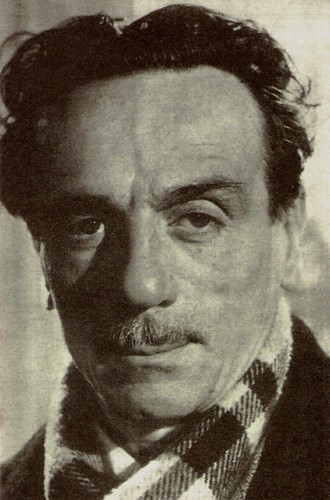
Italian postcard.
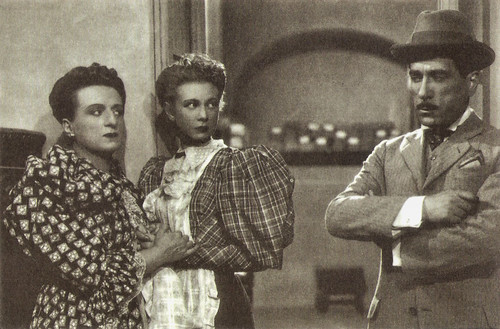
Italian postcard. Film scene with at left Titina de Filippo and right Eduardo De Filippo. In between them an unknown actress.
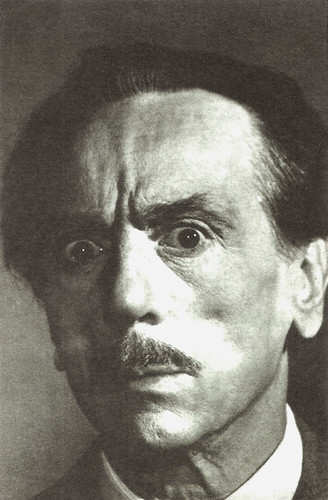
Italian postcard.
I do not pay you!
Eduardo De Filippo was born in Naples, Italy in 1900. He was the illegitimate son of actor/playwright Eduardo Scarpetta and theatre seamstress/costumer Luisa De Filippo. His sister was actress Titina De Filippo and his brother was actor/writer Peppino De Filippo .
Eduardo began acting at the age of four or five, the sources differ. According to Italica , the website of Rai International, he made his debut in 1904 as a Japanese child in La geisha (The Geisha), written by his father. The next year, he was Peppiniello in his father's comedy Miseria e nobiltà (Poverty and Nobility).
In 1914 he joined the regular staff of his step-brother Eduardo Scarpetta's theatre company, where he stayed until 1920 when he was called up for military service. In 1922, on completing his military service, he resumed his acting career in the theatre.
Like his father, he also started to write for the stage. Among his early plays are Farmacia di turno (The All-night Chemist, 1920), Uomo e galantuomo (Man and Gentleman, 1922), Requie a l'anema soja/I morti non fanno paura (May his soul rest, 1926) and Filosoficamente (Philosophically, 1928).
In the early 1930s, he wrote Ogni anno punto e da capo (Every Year Back from the Start, 1931), È arrivato 'o trentuno (The 31st is Here, 1931), Natale in casa Cupiello (Christmas at the Cupiello's, 1931) and La voce del padrone/Il successo del giorno (Success of the Day, 1932).
In 1932 he formed a theatre company with his brother Peppino and sister Titina, called Compagnia del Teatro Umoristico I De Filippo.
From 1933 they also appeared in films. In the French-Italian comedy Tre uomini in frack/Three Lucky Fools (Mario Bonnard, 1933), Eduardo co-starred with opera tenor Tito Schipa and French actor Fred Pasquali.
It was followed by Il cappello a tre punte/Three Cornered Hat (Mario Camerini, 1934) and Quei due/These two (Gennaro Righelli, 1935). He started to directed the comedies he starred in, like In campagna è caduta una stella/In the Country Fell a Star (Eduardo De Filippo, 1939).
With Titina and Peppino De Filippo , he played in the comedy Non ti pago!/I do not pay you! (Carlo Ludovico Bragaglia, 1942), which he also co-wrote. The trio enjoyed success in both mediums, but broke up soon after World War II ended.
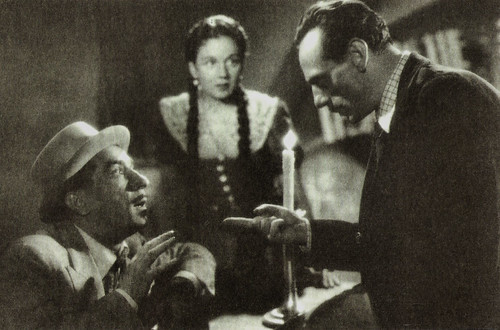
Italian postcard. Photo: publicity still of Casanova farebbe così/Casanova Would Do It That Way! (Carlo Ludovico Bragaglia, 1942) with Peppino and Eduardo De Filippo and in between them Clelia Matania.
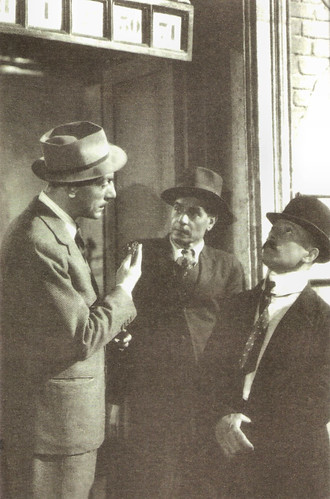
Italian postcard. Eduardo De Filippo and Totò in one of their many comedies.
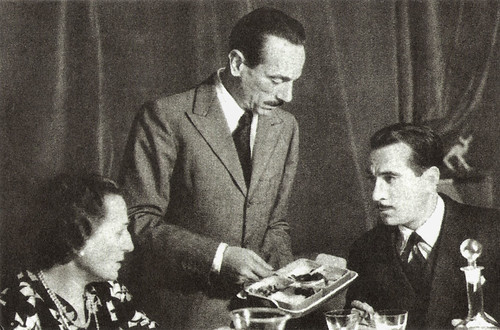
Italian postcard. Photo of Titina, Eduardo and Peppino De Filippo .
Life Begins Anew
Eduardo De Filippo founded the Compagnia di Eduardo, which in 1946 staged Questi fantasmi (Ghosts - Italian Style), followed by the hugely successful Filumena Marturano, which was to become the most famous role of his sister Titina.
Other plays were Napoli milionaria (The Millions of Naples, 1945), Le voci di dentro (Inner Voices, 1948), Mia famiglia (Family of Mine, 1955) and Sabato, domenica e lunedì (Saturday, Sunday and Monday, 1959).
In the cinema, he appeared with Alida Valli and Fosco Giachetti in the drama La vita ricomincia/Life Begins Anew (Mario Mattoli. 1945). It was the second most popular Italian film of the year after Roberto Rossellini's Paisan.
He also appeared in dramas like Assunta Spina/Scarred (Mario Mattoli, 1948) starring Anna Magnani , but De Filippo is better known for his comedies like Napoli milionaria/The Millions of Naples (Eduardo De Filippo, 1950) based on his own play, Filumena Marturano (Eduardo De Filippo, 1951) featuring Titina and the anthology film L'oro di Napoli/The Gold of Naples ( Vittorio De Sica , 1954). In a segment with Tina Pica he played ‘professor’ Ersilio Micci, a ‘wisdom seller’ solving problems.
In 1964, Filomena Maurano was filmed again as Matrimonio all'italiana/Marriage Italian Style ( Vittorio De Sica , 1964) starring Sophia Loren and Marcello Mastroianni .
One of De Filippo’s most successful films as a director was Fortunella/Happy-go-lucky Girl (Eduardo De Filippo, 1958) featuring Giulietta Massina . Other interesting films are L'amore più bello/The Most Beautiful Love (Glauco Pellegrini, 1958) with Alida Valli and child star Edoardo Nevola, the war drama Tutti a casa/ Everybody Go Home (Luigi Comencini, 1960) with Alberto Sordi, and the fantasy Fantasmi a Roma/Ghosts of Rome (Antonio Pietrangeli, 1961) starring Marcello Mastroianni.
Later he mostly appeared on television. In 1973 his play Sabato, domenica e lunedì (Saturday, Sunday and Monday, 1959), was put on at the Old Vic theatre in London. The production directed by Franco Zeffirelli and starring Laurence Olivier , won the London drama critics' award.
In 1981, Eduardo De Filippo was appointed life senator of the Italian Republic. He died four years later in Rome at the age of 84.
His last screen appearance was in the TV mini-series Cuore/Heart (Luigi Comencini, 1984) with Johnny Dorelli.
De Filippo was married three or maybe four times: to Vanna Polverosi (?), Dorothy Pennington (1928-1956), Thea Prandi (1956-1959), with whom he had two children, and to Isabella Quarantotti (1977-1984). His artistic legacy has been carried over by his son, Luca De Filippo.
His plays are often used for TV films, such as Filumena Marturano (Franza Di Rosa, 2010) featuring Mariangela Melato and Sabato, domenica e lunedì/Saturday, Sunday and Monday (Franza Di Rosa, 2012) with Massimo Ranieri.
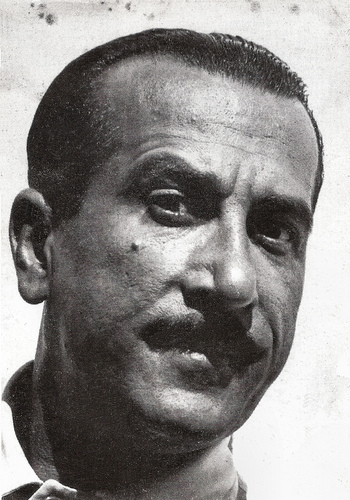
Peppino De Filippo . Italian postcard in the series Gli Artisti di Napoli.
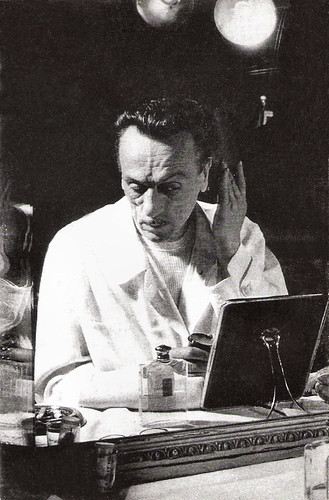
Italian postcard in the series Gli Artisti di Napoli.
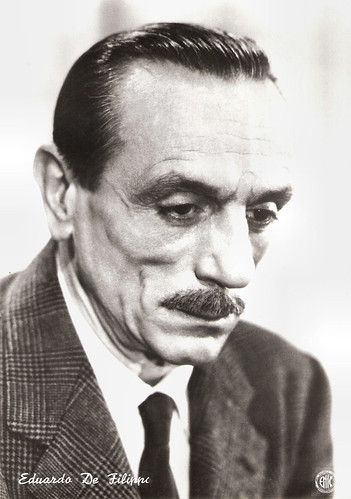
Italian postcard by Bromofoto, Milano, no. 969. Photo: ENIC. Eduardo De Filippo in Traviata '53 (Vittorio Cottafavi, 1953).
Sources: (IMDb), Italica, Wikipedia and

Italian postcard.

Italian postcard. Film scene with at left Titina de Filippo and right Eduardo De Filippo. In between them an unknown actress.

Italian postcard.
I do not pay you!
Eduardo De Filippo was born in Naples, Italy in 1900. He was the illegitimate son of actor/playwright Eduardo Scarpetta and theatre seamstress/costumer Luisa De Filippo. His sister was actress Titina De Filippo and his brother was actor/writer Peppino De Filippo .
Eduardo began acting at the age of four or five, the sources differ. According to Italica , the website of Rai International, he made his debut in 1904 as a Japanese child in La geisha (The Geisha), written by his father. The next year, he was Peppiniello in his father's comedy Miseria e nobiltà (Poverty and Nobility).
In 1914 he joined the regular staff of his step-brother Eduardo Scarpetta's theatre company, where he stayed until 1920 when he was called up for military service. In 1922, on completing his military service, he resumed his acting career in the theatre.
Like his father, he also started to write for the stage. Among his early plays are Farmacia di turno (The All-night Chemist, 1920), Uomo e galantuomo (Man and Gentleman, 1922), Requie a l'anema soja/I morti non fanno paura (May his soul rest, 1926) and Filosoficamente (Philosophically, 1928).
In the early 1930s, he wrote Ogni anno punto e da capo (Every Year Back from the Start, 1931), È arrivato 'o trentuno (The 31st is Here, 1931), Natale in casa Cupiello (Christmas at the Cupiello's, 1931) and La voce del padrone/Il successo del giorno (Success of the Day, 1932).
In 1932 he formed a theatre company with his brother Peppino and sister Titina, called Compagnia del Teatro Umoristico I De Filippo.
From 1933 they also appeared in films. In the French-Italian comedy Tre uomini in frack/Three Lucky Fools (Mario Bonnard, 1933), Eduardo co-starred with opera tenor Tito Schipa and French actor Fred Pasquali.
It was followed by Il cappello a tre punte/Three Cornered Hat (Mario Camerini, 1934) and Quei due/These two (Gennaro Righelli, 1935). He started to directed the comedies he starred in, like In campagna è caduta una stella/In the Country Fell a Star (Eduardo De Filippo, 1939).
With Titina and Peppino De Filippo , he played in the comedy Non ti pago!/I do not pay you! (Carlo Ludovico Bragaglia, 1942), which he also co-wrote. The trio enjoyed success in both mediums, but broke up soon after World War II ended.

Italian postcard. Photo: publicity still of Casanova farebbe così/Casanova Would Do It That Way! (Carlo Ludovico Bragaglia, 1942) with Peppino and Eduardo De Filippo and in between them Clelia Matania.

Italian postcard. Eduardo De Filippo and Totò in one of their many comedies.

Italian postcard. Photo of Titina, Eduardo and Peppino De Filippo .
Life Begins Anew
Eduardo De Filippo founded the Compagnia di Eduardo, which in 1946 staged Questi fantasmi (Ghosts - Italian Style), followed by the hugely successful Filumena Marturano, which was to become the most famous role of his sister Titina.
Other plays were Napoli milionaria (The Millions of Naples, 1945), Le voci di dentro (Inner Voices, 1948), Mia famiglia (Family of Mine, 1955) and Sabato, domenica e lunedì (Saturday, Sunday and Monday, 1959).
In the cinema, he appeared with Alida Valli and Fosco Giachetti in the drama La vita ricomincia/Life Begins Anew (Mario Mattoli. 1945). It was the second most popular Italian film of the year after Roberto Rossellini's Paisan.
He also appeared in dramas like Assunta Spina/Scarred (Mario Mattoli, 1948) starring Anna Magnani , but De Filippo is better known for his comedies like Napoli milionaria/The Millions of Naples (Eduardo De Filippo, 1950) based on his own play, Filumena Marturano (Eduardo De Filippo, 1951) featuring Titina and the anthology film L'oro di Napoli/The Gold of Naples ( Vittorio De Sica , 1954). In a segment with Tina Pica he played ‘professor’ Ersilio Micci, a ‘wisdom seller’ solving problems.
In 1964, Filomena Maurano was filmed again as Matrimonio all'italiana/Marriage Italian Style ( Vittorio De Sica , 1964) starring Sophia Loren and Marcello Mastroianni .
One of De Filippo’s most successful films as a director was Fortunella/Happy-go-lucky Girl (Eduardo De Filippo, 1958) featuring Giulietta Massina . Other interesting films are L'amore più bello/The Most Beautiful Love (Glauco Pellegrini, 1958) with Alida Valli and child star Edoardo Nevola, the war drama Tutti a casa/ Everybody Go Home (Luigi Comencini, 1960) with Alberto Sordi, and the fantasy Fantasmi a Roma/Ghosts of Rome (Antonio Pietrangeli, 1961) starring Marcello Mastroianni.
Later he mostly appeared on television. In 1973 his play Sabato, domenica e lunedì (Saturday, Sunday and Monday, 1959), was put on at the Old Vic theatre in London. The production directed by Franco Zeffirelli and starring Laurence Olivier , won the London drama critics' award.
In 1981, Eduardo De Filippo was appointed life senator of the Italian Republic. He died four years later in Rome at the age of 84.
His last screen appearance was in the TV mini-series Cuore/Heart (Luigi Comencini, 1984) with Johnny Dorelli.
De Filippo was married three or maybe four times: to Vanna Polverosi (?), Dorothy Pennington (1928-1956), Thea Prandi (1956-1959), with whom he had two children, and to Isabella Quarantotti (1977-1984). His artistic legacy has been carried over by his son, Luca De Filippo.
His plays are often used for TV films, such as Filumena Marturano (Franza Di Rosa, 2010) featuring Mariangela Melato and Sabato, domenica e lunedì/Saturday, Sunday and Monday (Franza Di Rosa, 2012) with Massimo Ranieri.

Peppino De Filippo . Italian postcard in the series Gli Artisti di Napoli.

Italian postcard in the series Gli Artisti di Napoli.

Italian postcard by Bromofoto, Milano, no. 969. Photo: ENIC. Eduardo De Filippo in Traviata '53 (Vittorio Cottafavi, 1953).
Sources: (IMDb), Italica, Wikipedia and
Published on June 27, 2019 22:00
Paul van Yperen's Blog
- Paul van Yperen's profile
- 13 followers
Paul van Yperen isn't a Goodreads Author
(yet),
but they
do have a blog,
so here are some recent posts imported from
their feed.



